
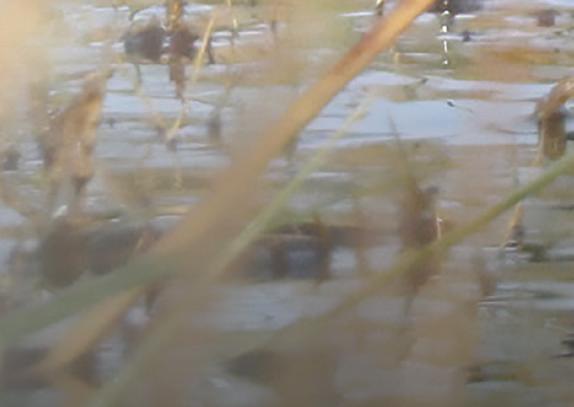
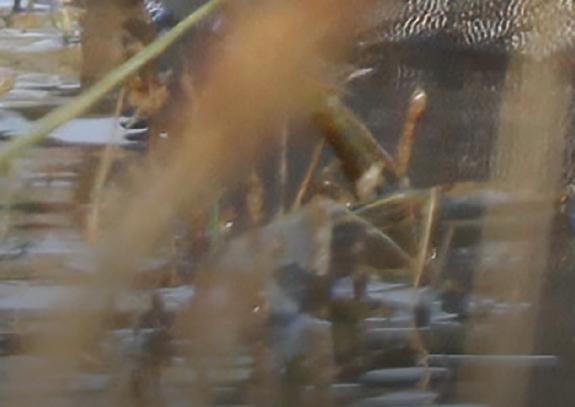

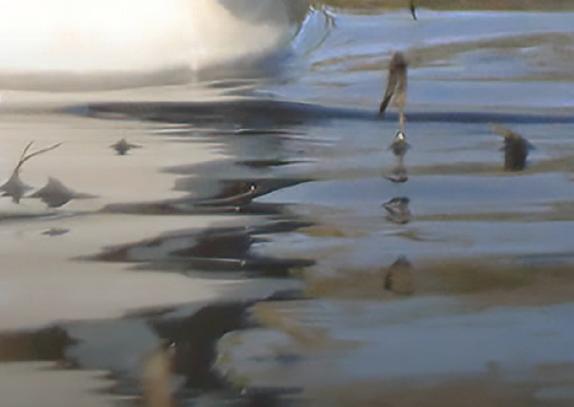




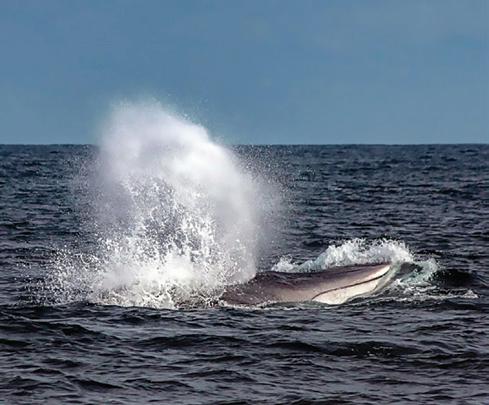

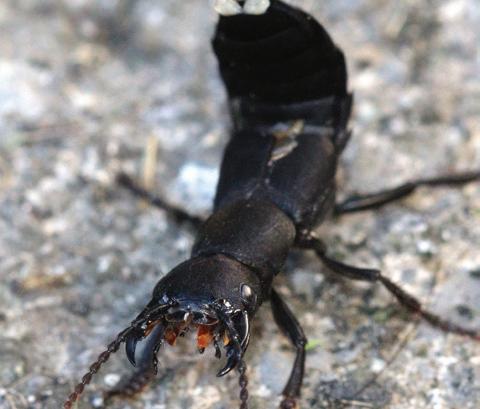


Buildingan Ark IRISH ISSN16495705 • WINTER ‘22 MAGAZINE OF THE IRISH WILDLIFE TRUST • DEVIL’S COACH HORSE • FIN WHALE • COMMON LIZARD SPOTTED IN IRELAND: IRELAND’S BEST WILDLIFE MAGAZINE REWILDING PERCEPTIONS AVIAN FLU OFFSETTING FORESTRY
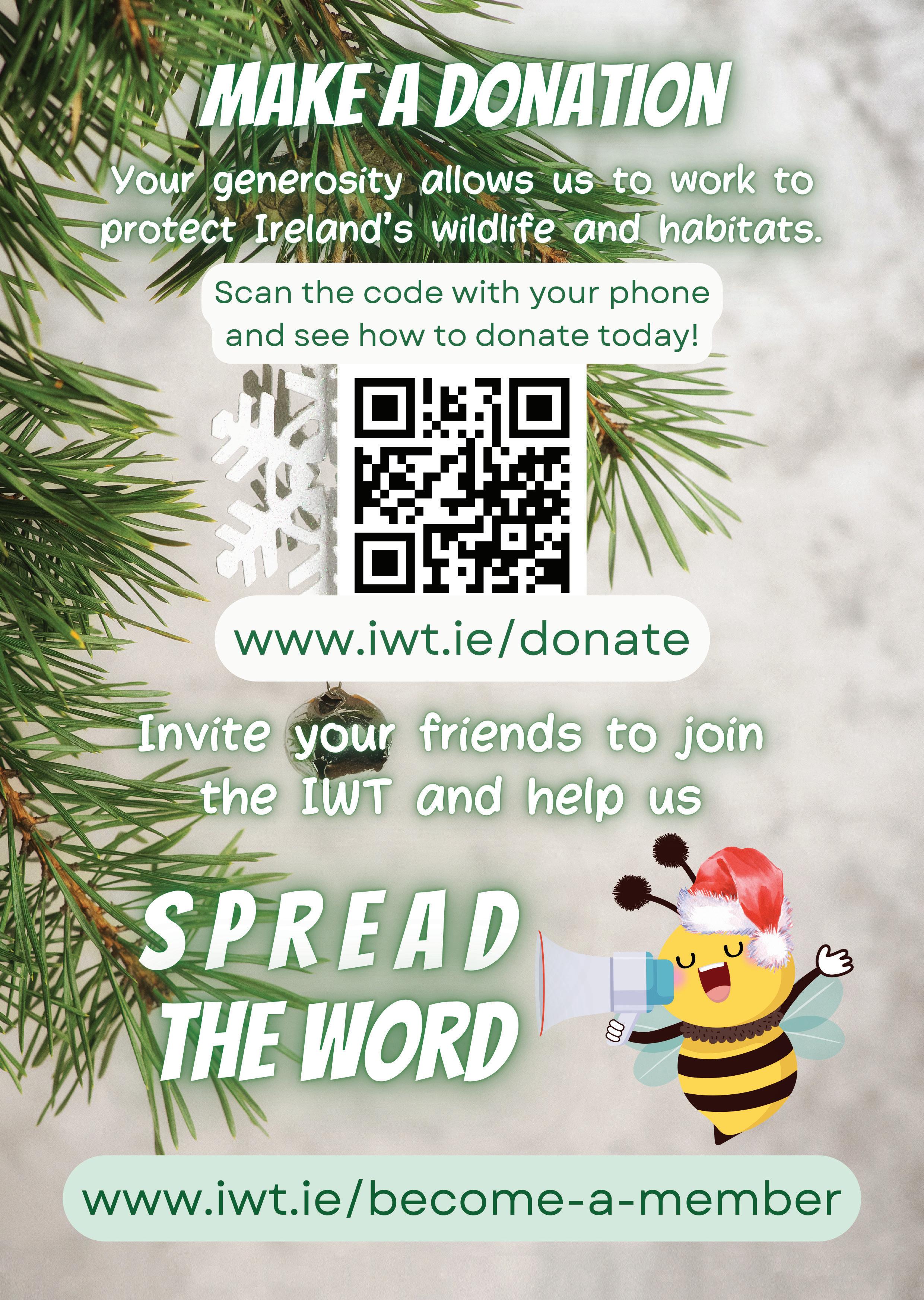
All articles © 2022 No part of this publication including the images used may be reproduced, stored in a retrieval system or transmitted in any form or by any means without written permission from the publisher. Opinions and comments expressed herein are not necessarily those of the publisher. While every effort has been made to ensure that all information contained in this publication is factual and correct at time of going to press, Ashville Media Group and the Irish Wildlife Trust cannot be held responsible for any inadvertent errors or omissions contained herein. Printed on

Please recycle this copy of Irish Wildlife
Chairperson’s Comment


Dear friends of the Irish Wildlife Trust (IWT), nature teaches us that hibernation, rest and restoration leads to new beginnings, and a closer look at the bare tree branches shows us the buds are busy preparing for spring. I love the sense of indulgence, sleep and rest that comes with hibernation, and although there’s always lots to enjoy in the great outdoors, there’s nothing like coming in from a walk to get cosy in front of an open re! As the winter days settle in, I hope you enjoy the fresh air and take some time to rest and restore, re ect on the year gone by and prepare for new beginnings in the year ahead.
In this issue of our magazine, we re ect on the increased awareness of Marine Protected Areas since the launch of the Fair Seas campaign and we’re thrilled that October brought legal protection for basking sharks. Our members’ photos always bring joy; we learn about the handsome rook, and raise important questions on biodiversity loss, the forthcoming Forest Strategy and rewilding. e beautiful article “build an ark” shares a vision for us to become “guardian’s, not gardeners”, and I’m already planning changes on my own little patch.

Our recent AGM created space to look back at our performance, and we had two long-standing directors step down. I would like to say a big thank you to Seán Meehan and Peter Cu e who have been board members for many years and have now stepped down. Seán was the chair of the board and Peter was our treasurer. Both leave a legacy for wildlife in Ireland and the IWT being the highly respected organisation it is today. ank you Peter and Seán, we will miss you.

During our AGM, we also appointed two new directors and we’re looking forward to welcoming Lisa O’Mahony and Sean Murphy to our board. It’s an important time to bring new perspectives as we take time to refresh our strategy for the future.

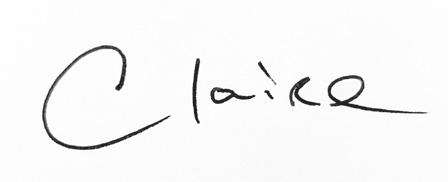
With the year coming to a close, I would like to send thanks to our IWT sta , board, branches and to you, our members. is has been a busy year and we’re planting the seeds for even greater impact for nature through 2023 and beyond.
As always, I am always interested to hear from you, our members. Feel free to drop me a note at claire@iwt.ie
Wishing you love, light, rest and restoration for this winter season,
Pass it on. If you’re finished with your Irish Wildlife don’t throw it in the bin. Pass it on to someone who you think may enjoy it – or ask your local library or doctor’s office to leave it in the reception. You’ll help the environment and the IWT while you’re at it. Irish Wildlife is 100% recyclable, so if you do choose to throw it out, please put it in the green bin.
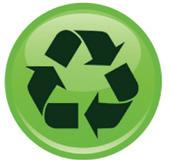
WELCOME Irish Wildlife Winter ‘22 1
Claire Walsh, Chair of the Irish Wildlife Trust claire@iwt.ie
Contents page credits: Butter y gathering pink owers in a garden Devil’s coach horse beetle by Marcus Maher
Lynx Strawberry tree by Zoe Devlin Large emerald Basking shark by Mike Brown
Cover Image Credit Pintail by Davide Idrato
Published by Ashville Media Group www.ashville.com
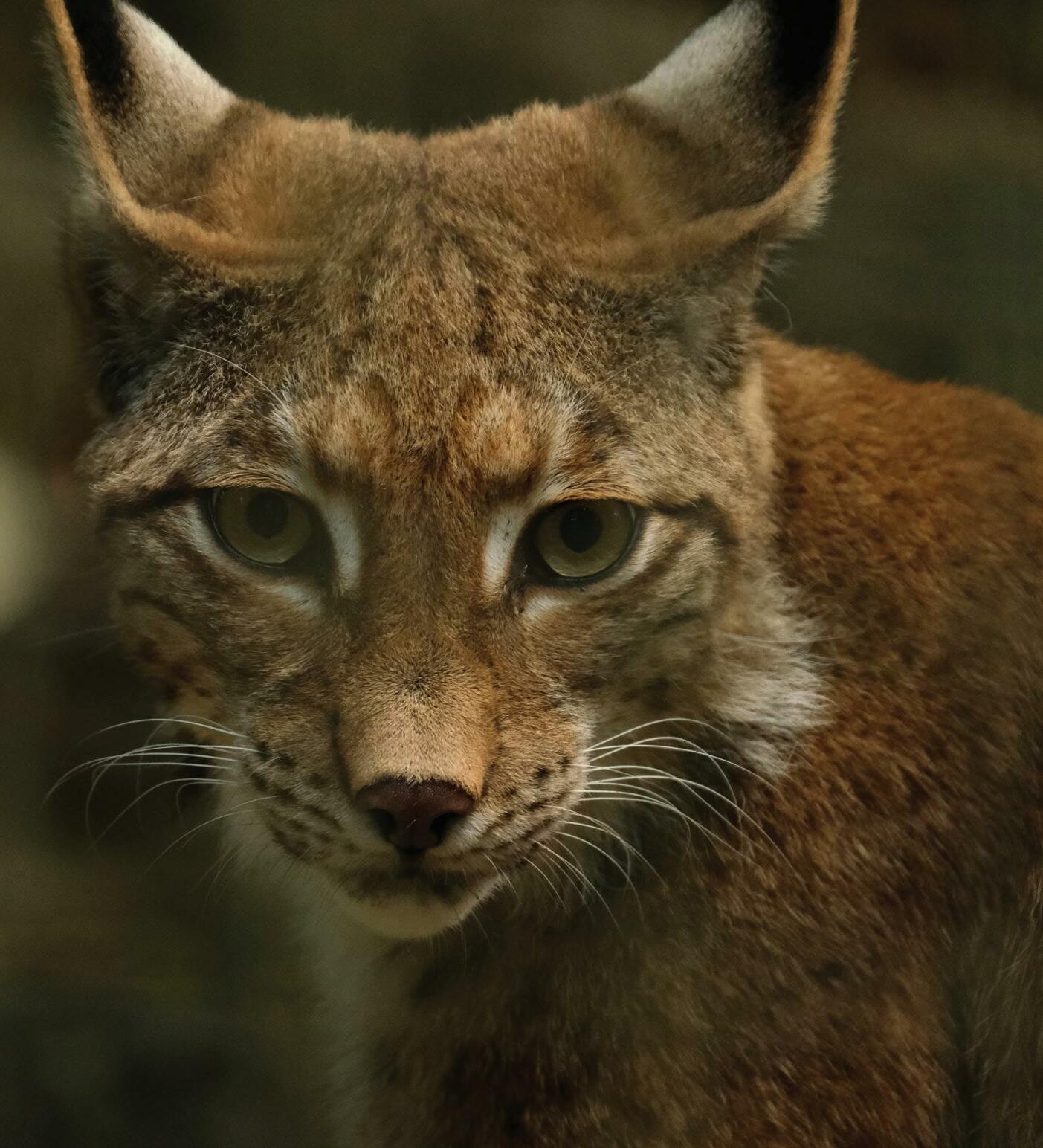

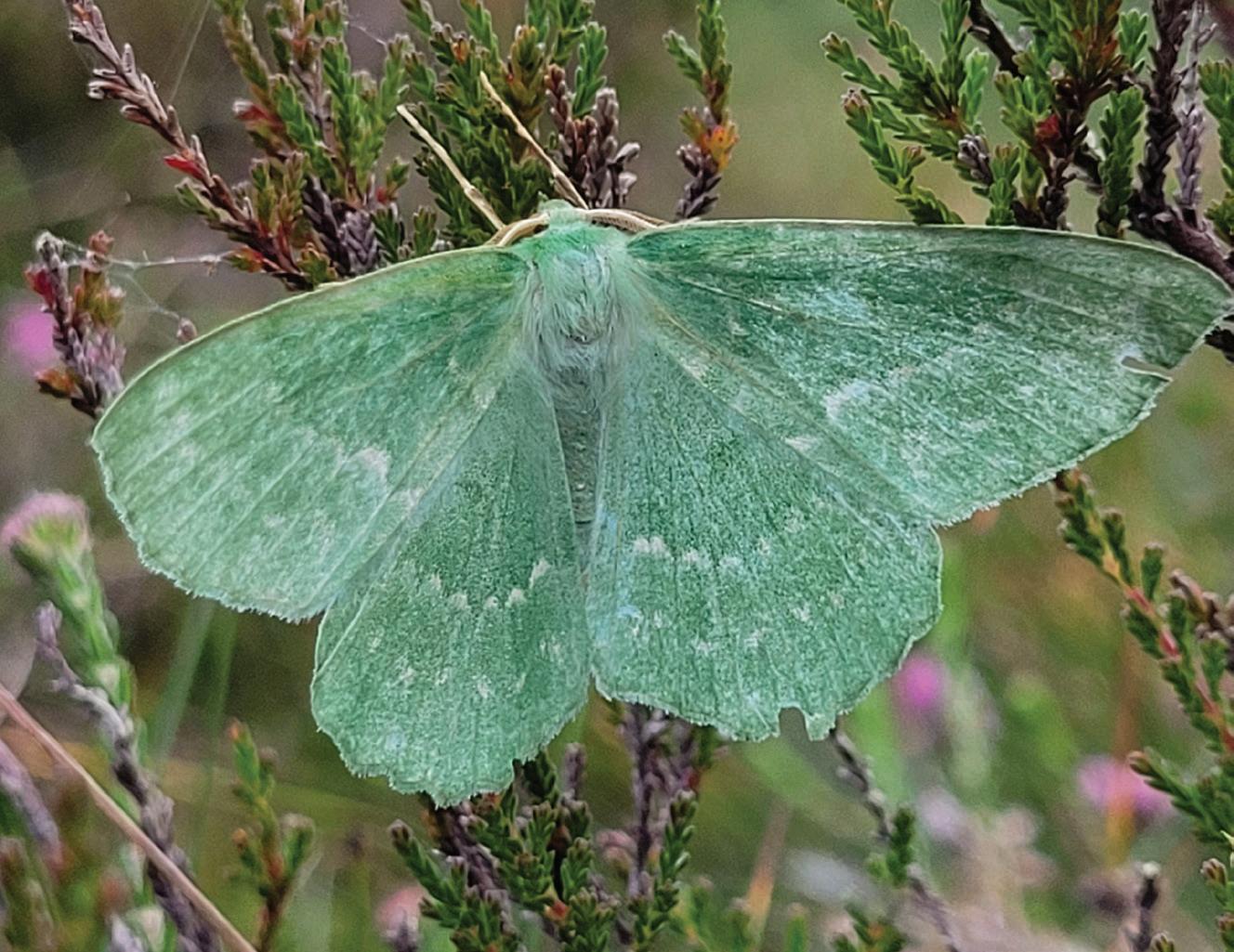
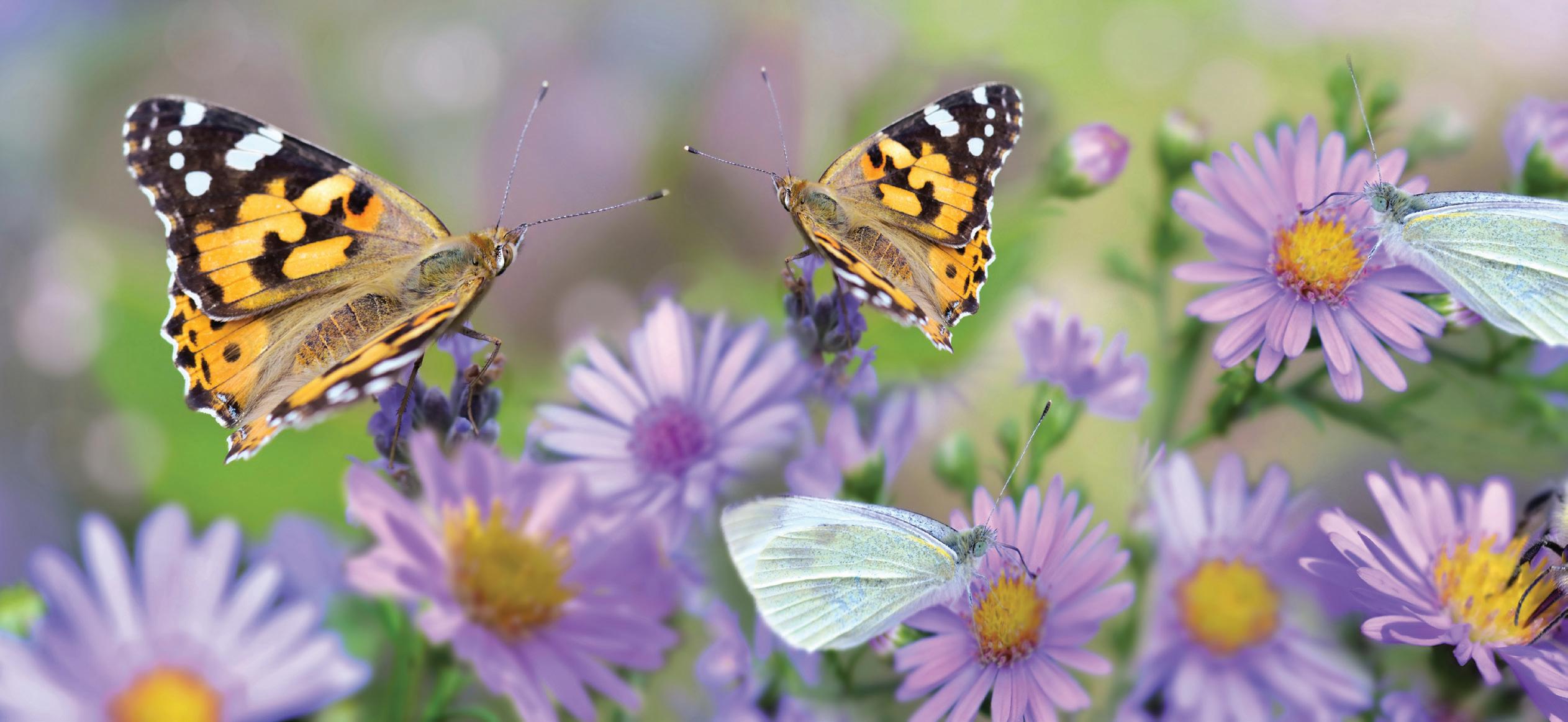
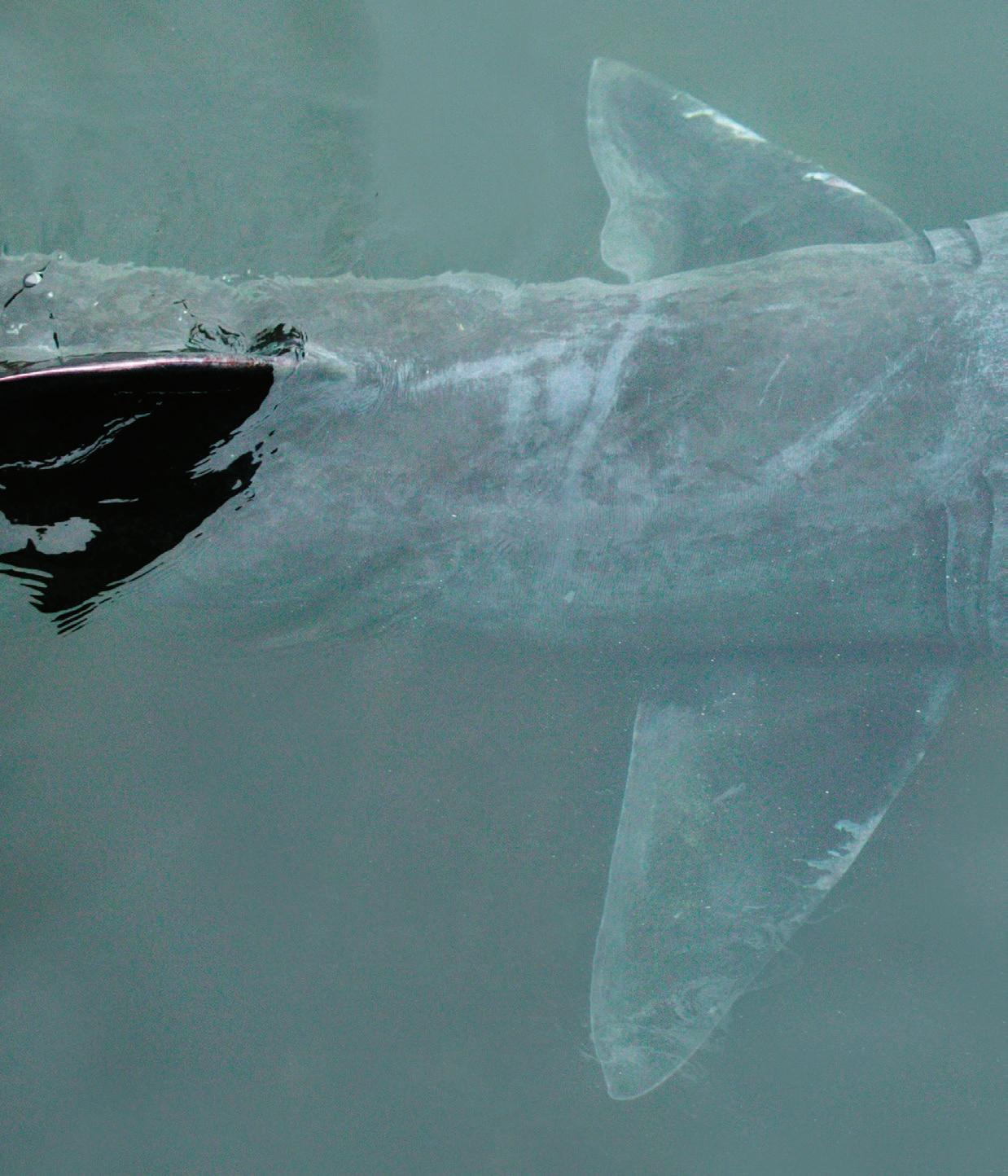
2 Irish Wildlife Summer “22
ABOUT US Discover more about the work of the IWT and how you can get involved.

CONSERVATION NEWS Tim Carbon compiles the latest national and international news from the world of conservation
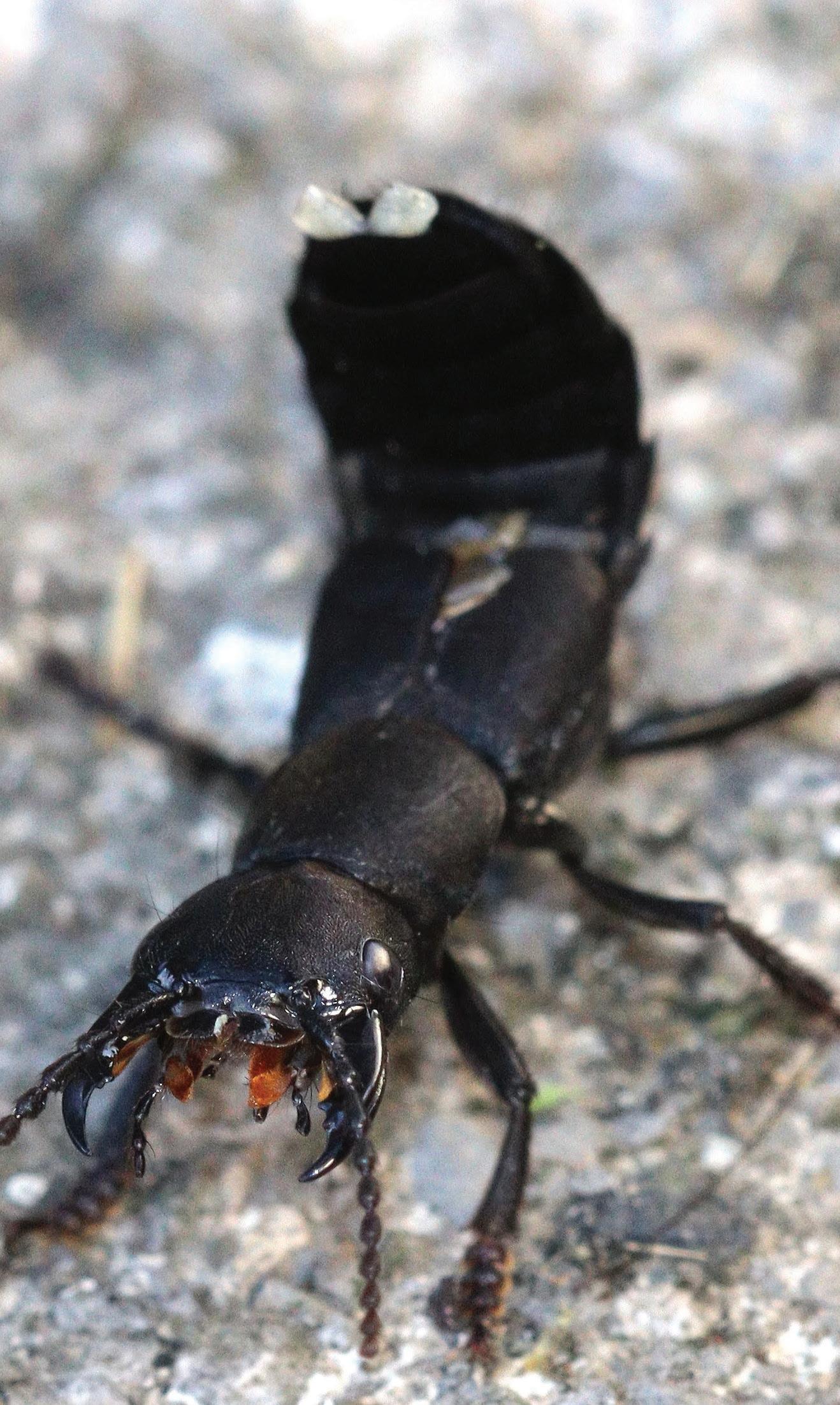
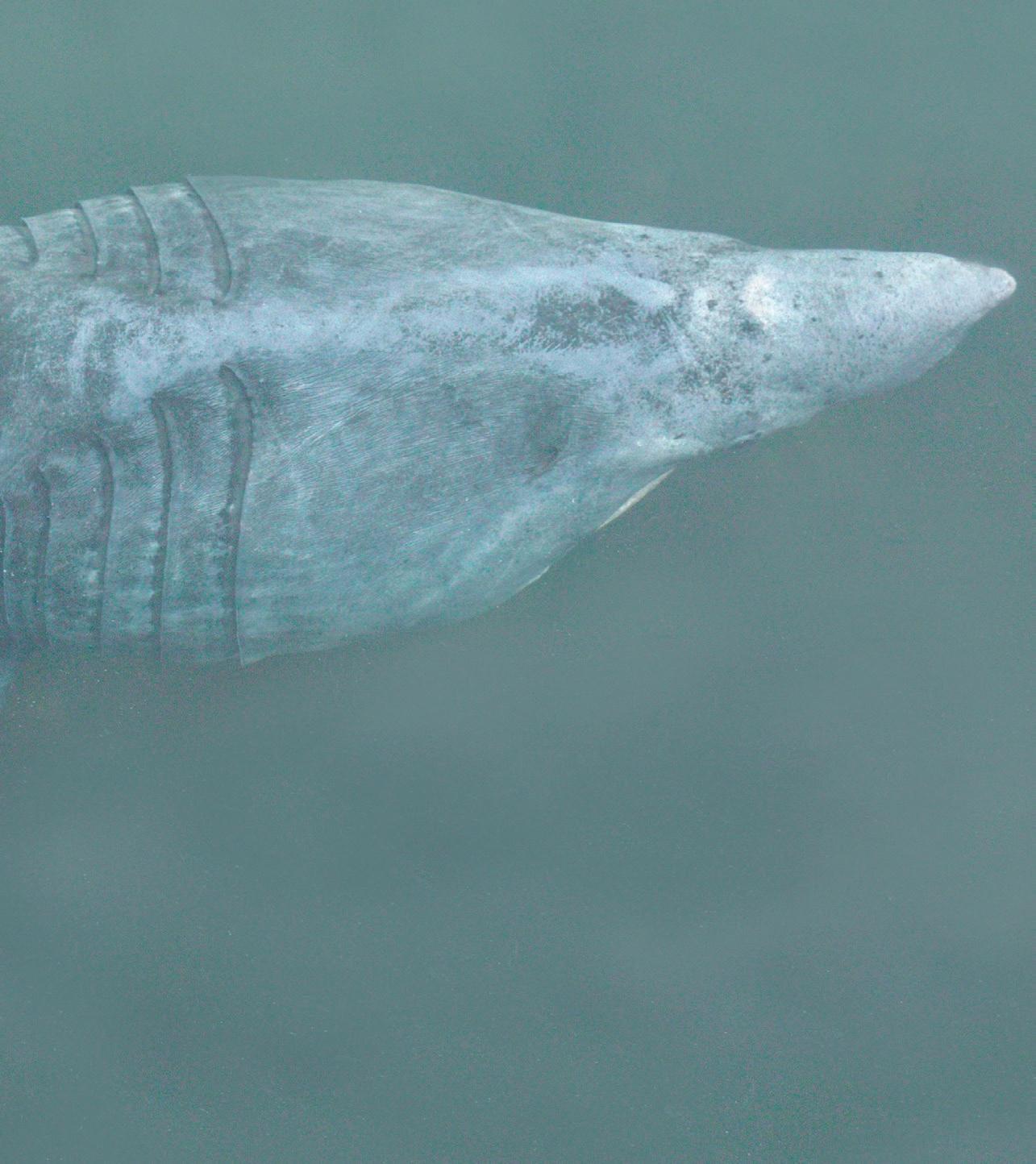
FIELD REPORT Irish Wildlife Winter ‘22 3
05
10
16
20
22
24
26
29
30
32
34
36
Contents 04
ACTIVITY UPDATE Updates on IWT campaigns and activities
WE ARE THE ARK Mary Reynolds’ new book on acts of restorative kindness for life on earth
WILD IDEAS New research on the perceptions of rewilding in Ireland
GORDON D’ARCY What does the future hold for our wildlife?
WINTER FOCUS Ireland is failing to treat wastewater to a proper standard
CITIZEN SCIENCE Recruiting citizens to research rooks
AN CAT CRAINN Kate Mac Lochlainn
FRONTLINE Research shows how rewetting of bogs can lead to climate cooling
TREE PLANTING The trouble with carbon offsetting
FACEBOOK PHOTOS
COMPETITION Your chance to win a copy of an exciting new nature book
IMAGES THIS PAGE:
About Us
e Irish Wildlife Trust was founded in 1979 and aims to conserve wildlife and the habitats it depends on throughout Ireland, while encouraging a greater understanding and appreciation of the natural world.

e IWT is dedicated to creating a better future for Ireland’s wildlife through: Motivating and supporting people to take action for wildlife.
Education and raising awareness of all aspects of Irish wildlife and conservation issues. Research of the natural environment. Acquiring and managing nature reserves to safeguard species and habitats.
Lobbying decision-makers at all levels to promote policy in Ireland that provides a sustainable future for wildlife and people. Working in partnership with other organisations to achieve results that matter for conservation.

Irish Wildlife is published quarterly by the IWT.

e IWT encourages action at a local level and has a number of branches around the country: Dublin: dublinbranch@iwt.ie facebook.com/DublinBranchIrishWildlife Trust, dubliniwt.blogspot.ie
Waterford: Denis Cullen, iwtwaterfordbranch@gmail.com, deniscullen@eircom.net, irishwildlifetrust. blogspot.ie
Kerry: Ger, iwtkerry@gmail.com, www.facebook.com/KerryIWT Limerick: limerickbranch@iwt.ie / https://www.facebook.com / IWTLimerickBranch
Galway: Dan, iwtgalway@gmail.com, www.facebook.com/IWTgalwaybranch Laois/O aly: Ricky, iwtlaoiso aly@gmail.com, www.facebook.com/IWTlaoiso alybranch Monaghan: monaghanbranch@iwt.ie
HOW CAN YOU HELP?



You, our members, make the IWT what it is. rough your subscriptions and support we can undertake the projects that are bene ting Ireland’s wildlife. If you would like to help more, here’s what you can do:
• Make a one-o donation to the IWT.
• Give IWT membership as a gi .
• Volunteer – we are always looking for people to help out. ere are lots of ways to get involved, from helping with important admin work in our o ce to helping us increase membership by volunteering at public events. See our website www.iwt.ie for details or contact the o ce directly.

• Do you have land that you would like used for conservation? We are always on the lookout to establish new sites to enhance wildlife or provide education opportunities.
• Remember us in your will. Why not leave a lasting legacy towards conserving Ireland’s natural heritage? e IWT uses all funds towards our campaigns, managing reserves and our education programmes. Please visit www.mylegacy.ie.
• Set up a branch. Are you passionate about wildlife and are in a county that does not have an IWT branch? Contact the o ce and we can give you the support you need to get up and running.
Keep up to date on all the latest news from the Irish Wildlife Trust on www.iwt.ie
Irish Wildlife Winter ‘22 4 IRISH WILDLIFE TRUST
HAVE COMMENTS? Editor: Pádraic Fogarty Magazine queries email: editor@iwt.ie Information on campaigning and policies email: irishwildlife@iwt.ie Snail mail: The Irish Wildlife Trust, 8 CABRA ROAD, DUBLIN 7, D07 T1W2 Web: www.iwt.ie Social media: facebook.com/IrishWildlifeTrust twitter.com/Irishwildlife instagram.com/irishwildlifetrust/ Registered Charity Number: 20010966
TOP: An cat crainn by Mike Brown BELOW: Common Lizard by Jonathan Rosboroughn
Supported by
CONSERVATION NEWS
INTERNATIONAL NEWS
The latest national and international news from the conservation world, compiled by Tim Clabon

Lobbyists for Inaction
Research carried out by InfluenceMap (a UK based ‘think tank’ that provides data and analysis on how business and finance are affecting the climate crisis using evidence-based assessments) demonstrated in a pilot study carried out in the EU and US that industry associations representing key sectors and some of the largest companies in the world are lobbying to delay, dilute and rollback critically needed policy aimed at preventing and reversing biodiversity loss.
Biodiversity loss is occurring globally at unprecedented rates and faster than at any other time in human history. Despite increasing awareness of the biodiversity crisis, the world failed to meet any of the UN biodiversity targets for the last decade. At the UN Biodiversity Conference (COP15) to be held in Montreal in December 2022, governments from around the world will negotiate the post-2020 global biodiversity framework; a set of targets and goals for the next 10 years aimed at reversing biodiversity loss.
National policies are emerging to address the biodiversity crisis, including the 2030 Biodiversity Strategy in the EU. In the US, the Biden administration is repealing Trump administration-era rollbacks to environmental regulations, as well as introducing some new policies, including a target to protect 30% of land and sea by 2030. As InfluenceMap has observed with climate policies, the effort by governments on biodiversity is being met with resistance from sectors that feel they may be negatively impacted - including agriculture, fisheries, forestry & paper, mining and oil & gas.
The pilot study focused on EU and US industry associations representing five key sectors with the greatest impact on biodiversity loss, as well as the major cross sector industry associations in each region. These are the: International Association of Oil and Gas Producers (IOGP), American Petroleum Institute (API), Euracoal, National Mining
Association (NMA), Confederation of European Paper Industries (Cepi), American Forest & Paper Association (AF&PA), American Farm Bureau Federation (AFBF), Copa Cogeca (farming industry), National Fisheries Institute, Europeche (fishing industry), BusinessEurope, and the US Chamber of Commerce.
The research showed that these industry associations are opposed to almost all major biodiversity-relevant policies and regulations, with 89% of the policy engagement analyzed found to be aimed at blocking progress on addressing biodiversity loss. Although industry associations, especially in the US, appear reluctant to discuss the biodiversity crisis, they are clearly engaged on a wide range of policies with significant impacts on biodiversity loss. The members of these associations include some of the world’s largest and most powerful companies, including Saudi Aramco, JPMorgan Chase, Amazon, Apple, Bank of America, Toyota, Alphabet, Microsoft, Samsung and ExxonMobil. This research focused on the industry associations’ positions only, with future research needed to ascertain whether these are aligned or misaligned with the positions of individual companies. Many of the companies represented have already made commitments to protecting biodiversity, so the positions of the industry associations may not reflect individual companies' positions on what is an important subject.
The industry associations were scored and graded using new methodologies adapted from InfluenceMap’s methods for assessing corporate engagement on climate policy, looking at around 750 articles ranging from advertising, social media, speeches and direct lobbying of politicans.
More information and the report can be found at: https:// influencemap.org/report/Industry-Associations-BiodiversityPolicy-19612
CONSERVATION NEWS Irish Wildlife Winter '22 5
The Big Compost Experiment
The popularity of packaging made from compostable and biodegradable plastics is increasing but their impact on the environment needs to be fully assessed. Research published in Frontiers in Sustainability and carried out by researchers from University College London using data from 9,701 participants spread across the UK studied the capacity, opportunity and motivation to use compostable packaging. 1,648 people performed home compost experiments to test the performance of compostable plastics over a 24month period.
The research reported on the types of plastic tested and their disintegration under real home composting conditions. 14% of sampled packaging items were certified ‘industrial compostable’, while 46% had no compostable certification. The results showed that the public are confused about the meaning of labels on compostable and biodegradable plastic (in the EU there is currently no standard for home compostable packaging labeling). Of the compostable and biodegradable plastics tested the majority did not fully break down, including 60% of those certified as home compostable.
Of those who undertook the experiment, 902 participants finished the home compost test, with a total of 1,307 item results submitted. Of these, 55% reported that the item remained still clearly visible, 11% of results contain small pieces (<2 mm but still visible to participant) and 34% no longer visible / not found within participant home composting timeframes.
The researchers (and likely those who read the findings) found that home composting is not an effective way of processing packaging waste, nor has any beneficial environmental findings. In actual fact if the wrong material is composted this could lead to more microplastics in the environment.
More work is clearly needed and material scientists need to do more to develop packaging more suitable for home composting. In addition, the carbon footprint of transport and manufacturing compostable packaging can have, should not be overlooked.
The research also highlighted the inadequacy of the current labeling system which at best is well meaning but confusing, at worst another example of businesses greenwashing their activities in an effort to remain popular. Simply put reduce or reuse is the best option.
More information can be found at: https://www.frontiersin.org/articles/10.3389/ frsus.2022.942724/full
NEWS By Tim Clabon
Avian Flu
Although the disease has been circulating since 2020, and for a while seemed to be under control, Ireland once more sees the highly pathogenic avian influenza (HPAI) with a code name HPAIV A (H5N1) on the rise. It has already taken an enormous toll on wildfowl including geese, raptors and seabirds, as well as internationally important gannet populations.
Intensive surveillance by the National Parks and Wildlife Service (NPWS) during September found large numbers of dead gannets at breeding colonies and washed ashore at coastal sites. Of 80 birds submitted to State laboratories for testing, 60 tested positive. This is alarming as it shows the virus is widely spread throughout the wild bird population, affecting all coastlines.
This disease is highly contagious and has a near 100% mortality rate among flocks of birds. Its spread among colonies is all but certain when an infected individual is present. While the risk of disease spreading is constant throughout the year, from October onwards the risk increases due to the arrival of migrating species mixing with year-round native species.
Unfortunately, the loss of habitats, nesting grounds and feeding areas squeezes more birds into smaller areas so making the risk of spreading diseases all the more likely, adding further burdens to our wildlife resources.
The biggest path of infection is contact with other birds, however contact with bird droppings, fluid and sometimes surfaces contaminated with the virus can also cause infection.
ADVICE TO THE PUBLIC:
Do not take home any sick or dead bird. It is unwise to take these birds to rescue centres as this could spread the disease but if you feel you need to you must contact them first as they may not accept them.
If on public land also report dead birds to the local authority who will take care of cleaning the area, and landowner, if on private land. Keep dogs on leads in areas where sick or
dead birds are present.
Sick or dead wild birds should be reported to the Department of Agriculture, food and the marine by phone:
• avian influenza hotline: 01 607 2512 (during office hours)
• outside of office hours: 01 492 8026
The current advice from the Health Protection Surveillance Centre (HPSC) and the Health Service Executive (HSE) is that members of the public should not touch or pick up dead birds. If this is unavoidable:
• You must wear disposable protective gloves when picking up and handling dead wild birds
• Place the dead wild bird in a suitable plastic bag, preferably leak proof. Care should be taken not to contaminate the outside of the bag
• Swan-neck and tie the bag and place it in a second plastic bag
• Remove gloves by turning them inside out and then place them in the second plastic bag. Tie the bag and dispose of it in the normal household refuse bin
• You must wear disposable protective gloves when picking up and handling dead wild birds
• Place the dead wild bird in a suitable plastic bag, preferably leak proof. Care should be taken not to contaminate the outside of the bag
As with handling any wildlife make sure to wash your hands thoroughly with soap after coming into contact with any animal and do not touch any sick or dead birds. You should wash hands, nails and forearms thoroughly with soap and water after handling the dead bird. (Even after wearing gloves!).
More information is available at the links below: https://www.npws.ie/news/ notice-public-re-avian-flu-0 https://www.gov.ie/en/ publication/50ce4-avian-influenzabird-flu/

Irish Wildlife Winter '22 6 CONSERVATION NEWS
IRISH
By Regina Classen
Marine conservation:


A year in review
Irish Wildlife Winter '22 7
Surfers enter the sea from Inch Beach near Dingle
MARINE NEWS
It has been an exciting year for marine conservation in Ireland. While the cogs towards meaningful action move slowly, much has happened that is worth being optimistic about.
FAIR SEAS LAUNCH
In February 2022, Irish marine environmental NGOs joined forces to launch a new campaign called Fair Seas. For the first time, a dedicated team of staff along with support from the partner NGOs, are working towards achieving greater marine environmental protection in Ireland. Since February, the campaign has made considerable noise by being featured in the media and podcasts, being invited to give talks and having met the Taoiseach as well as most of the relevant ministers on several occasions.
REVITALISING OUR SEAS REPORT
On World Ocean Day 2021, Fair Seas launched the report titled ‘Revitalising Our Seas. Identifying Areas of Interest for Marine Protected Area (MPA)
Designation.’ The report shows how it would be possible to protect 36% of Ireland’s ocean territory enabling the country to meet its 2030 European targets. This would help to protect, conserve and restore vulnerable and important species and habitats, as well as ensuring that these habitats can act as huge natural carbon stores.
�

(L-R) Seth Horstmeyer, of Oceans 5, Aoife O’Mahony, of Fair Seas, Darragh O’Brien, TD, Minister for Housing, Local Government and Heritage, Oonagh Duggan, of BirdWatch Ireland, Malcolm Noonan, TD, Minister of State at the Department Housing, Local Government and Heritage and Kieran Flood, of the Irish Wildlife Trust

PIC: Conor Ó Mearáin
The report identifies 16 ‘Areas of Interest’ for MPA designation in Irish waters including eight coastal areas stretching along the coast of the Republic of Ireland from Donegal to Louth. These places are home to critically endangered sharks, globally important seabird colonies and animals threatened with extinction which rely on these areas for
breeding and feeding such as Atlantic puffins and blue whales.
UN OCEAN CONFERENCE
From the 27th of June to July 1st, Fair Seas attended the second UN Ocean Conference in Lisbon, Portugal. With over 300 side events taking place throughout the week, major announcements from government representatives at the conference, and a huge uptick in civil society representation compared to the 2017 event, it was a busy week from start to finish for the Fair Seas team. The team attended many side events taking place at the conference including those relating to MPAs, fisheries, ocean rewilding and national action plans relating to ocean conservation.

LEGAL PROTECTION FOR THE BASKING SHARK
As of October 3rd 2022, basking sharks in Irish waters are legally protected under
8 Irish Wildlife Winter '22 MARINE NEWS
Section 23 of Ireland’s Wildlife Act. Basking sharks are the second biggest sh in the sea, with females only reaching sexual maturity once they have grown to between 8 and 10 metres in length. It is now illegal to wilfully harm or disturb these ocean giants in Ireland.

BOTTOM FISHING CLOSURES IN IRELAND’S OFFSHORE WATERS
A new Implementing Act of the Commission Deep-sea Access Regulation, which came into force on October 10th, will see deep sea shing using gear such as trawls, gillnets and bottom longlines, banned in 87 sensitive zones in the North Atlantic. e closed area amounts to 16,000 km2 of EU waters, of which nearly 9,000 km2 are within the Irish Exclusive Economic Zone (EEZ). e Deep-sea Access Regulation aims to protect vulnerable marine ecosystems such as coral reefs and sea-pen elds between 400 and 800 metres depth. Waters below 800 metres depth are already fully protected from bottom shing.


Looking ahead…
MPA LEGISLATION
e Department of Housing, Local Government and Heritage is currently dra ing Ireland’s rst national MPA legislation. By the time this article is published, the Heads of Bill for the new legislation should already be published. Fair Seas and the IWT will engage with this process to ensure the legislation is robust and delivers the kinds of MPAs marine wildlife needs to thrive in Irish waters.
NATURE RESTORATION LAW
On the 22nd of June, the European Commission presented a legislative proposal for binding nature restoration targets, called the Nature Restoration Law. e Commission’s proposal is a huge milestone as it is the rst major piece of EU biodiversity legislation since the
Habitats Directive in 1992. e IWT will be heavily engaged with the legislative process of the Nature Restoration Law over the course of 2023. Engagement at this early stage is vital to ensure the law’s urgent adoption and implementation.
CONFERENCE SAVE THE DATE






Fair Seas will host its inaugural conference in Cork next June on World Ocean Day. We
and key stakeholders together to map out the next steps for MPAs in Irish waters. Sessions will focus on the designation and management of MPAs and learning from best practices across the world.
 "AS OF OCTOBER 3RD 2022, BASKING SHARKS IN IRISH WATERS ARE LEGALLY PROTECTED UNDER SECTION 23 OF IRELAND’S WILDLIFE ACT"
Basking shark by Mike Brown
"AS OF OCTOBER 3RD 2022, BASKING SHARKS IN IRISH WATERS ARE LEGALLY PROTECTED UNDER SECTION 23 OF IRELAND’S WILDLIFE ACT"
Basking shark by Mike Brown
We will bring ocean advocates, government, industry and key stakeholders together to map out the next steps for MPAs in Irish waters.
will bring ocean advocates, government, industry
Irish Wildlife Winter '22 9 MARINE NEWS

Irish Wildlife Winter ‘22 10 IWT NEWS
ACTIVITY UPDATE By Kieran Flood, IWT Coordinator
�Green emerald
�Pipistrelle. Photo by Maurice Flynn
Heritage Week 2022
It's eight thirty on a summer’s evening. There is a slight wind blowing off Dublin Bay as the last light of the day slants through the trees. A large group of people are gathering on a corner of the road at the edge of St Anne's Park. All generations are present, from young children to grandparents. There is an air of expectation, and even impatience from some, as more people arrive at the meeting point in twos and threes waiting for the evening’s entertainment to begin. The event is booked out and there are certainly a few people who have tried their luck and come along anyway without a booking. Is this a concert or light show that has brought everyone here in anticipation? You’d be forgiven for thinking so but you’d be wrong. This is our 2022 Heritage Week Dublin branch bat walk.
I’ve been running nature engagement events for over a decade now and I’ve noticed an uplifting and hopeful trend of late and that is that most of the events are now completely booking out. The desire to learn about and spend time in nature has strengthened in the collective consciousness of the people of Ireland. Nature conservation faces many structural, resourcing, policy and legislative obstacles but one thing is for sure – the level of community enthusiasm is no obstacle. People across the country are waking up to the love of nature or, you could say, that a love of nature is waking up in the people. I’ve been privileged to deliver nature workshops to primary school students over the years and the innate human fascination with and love of nature is always evident in young people. However it often gets lost inside us as we grow and have to make our way in the world with all the stress and distractions of modern life. Here at the Irish Wildlife Trust we have noticed an awakening of interest in nature and with it an awakening of concerns for our wild places, plants and animals (and fungi too).
The Heritage Council's Heritage Week is a time when nationwide engagement with nature can flourish. Heritage Week is an opportunity to celebrate our country's heritage with hundreds of free events all across Ireland squeezed into one week in mid-August. The emphasis on natural heritage has grown over the years and this year, with support from the Heritage Capacity Fund, we have gladly contributed to this list of biodiversity-focused events. In fact, our Monaghan branch was awarded the National Heritage Week County Winner award for their “Creative Heritage Inspired by Nature and its Music” event which was held in conjunction with the Local Authorities Waters Programme in Doohamlet Community Centre. This event explored some of the ways the sound of nature has influenced Irish creative culture. Our Monaghan branch members captured the essence of heritage week combining music, folklore and nature sounds into an
experience delving into our cultural connection with the natural world.
We started the week with the now regular IWT People for Bees event at the National Botanic Gardens in Glasnevin, County Dublin. It is an idyllic place to run such an event. We combined a short talk on the biology of wild Irish bees with a bee identification walk around the gardens where there was no lack of flowering plants on which to find these fascinating insect pollinators. As usual the organic vegetable garden proved the most beefriendly spot and we found plenty of bumblebees to identify and see up close. Bees were the topic of choice again for our other Monaghan branch event where we visited Rockcorry where a branch member hosted a bee ID event in their own garden. Their garden is a rewilding experiment in itself and the most rewarding part of the day was to learn about the wealth of local wildflowers that have emerged since nature was welcomed back in. Back in St Anne's our group waited patiently with bat detectors in hand as the sun set over a tree-lined park avenue while IWT volunteer Sean Meehan gave a fascinating talk on Ireland’s bats. The evening was very bright and we were starting to worry that no bats would show up before our own bedtime when all of a sudden a pair soprano pipistrelles danced into view foraging along the edge of the treeline. As the iconic silhouettes dived and wheeled in front of the group the bat detectors came to life with a cacophony of click pops and slaps as the echolocation calls played back to us in frequencies suitable for human ears. As a veteran of bat walks I still get a rush of excitement every time the first bat of the evening appears. Hearing the bat’s complex high frequency echolocation calls in real time rising and falling as it swoops by instantly draws one into another word. A world beyond our normal human experience. To see and hear these flying mammals gracefully pick tiny insects from the air in an ancient dance of cat and mouse (or bat and midge) never ceases to amaze. Particularly for those in the group who have never heard the call of a bat before. We finished the evening standing by the pond under an old stone folly watching dozens of bats dance over the surface of the dark water.
One of our group turned to me and told me she had the best night in ages and thanked us profusely for hosting the event, but the thanks really went to her for coming out on a weekday evening and engaging with nature and giving us hope that together we can save what so many of us now treasure - our natural heritage.
IWT NEWS Irish Wildlife Winter ‘22 11
"HERITAGE WEEK IS AN OPPORTUNITY TO CELEBRATE OUR COUNTRY'S HERITAGE WITH HUNDREDS OF FREE EVENTS ALL ACROSS IRELAND SQUEEZED INTO ONE WEEK IN MID-AUGUST"
Citizens’ Assembly on Biodiversity Loss
The Citizens’ Assembly (CA) on Biodiversity Loss was wrapping up its work as Irish Wildlife went to print. Since April of this year, 100 citizens have been deliberating on “the threats presented by biodiversity loss and the opportunities to reverse this loss”. They have been assisted in this task by Aoibhinn Ní Shúilleabháin who is chairing the process, as well as a panel of experts including academics and former civil servants. It has been a fascinating process to watch and one can only admire the time and engagement that have been forthcoming and for which the participants are not being paid.
As a crash course in biodiversity and the complex interplay with public policy, the videos (all of which are available to watch on YouTube) could form the basis of a diploma on the subject! The assembly has invited a range of speakers to give perspectives and answer questions including from public bodies, voluntary groups and specialist experts. The IWT was asked to speak as part of a delegation from the Irish Environmental Network, the umbrella group of environmental NGOs of which we are a part, along with An Tasice and Coastwatch. We had a few minutes to talk about our work which I used to emphasise the length of time we have been working in this area as well as how the technical solutions to many, if not all, of our environmental problems have already been worked out.
The participants have been quick to appreciate that policies to protect nature have not been successful largely because they conflict directly with other policies, particularly those in relation to our food system. Among their tasks therefore has been to identify “opportunities to develop greater policy coherence and strategic synergies between biodiversity policy and other policy priorities”.
In our submission to the CA, sent in early September, we boiled the problem down to two areas: holding the State to account for implementing current and
future commitments; and reconnecting people to nature. Much of our problem stems from the fact that breaking environmental law is largely seen as a victimless crime. It has been very hard for politicians to win support for implementing measures particularly
where they result in difficult change or short-term pain. Nature has been persistently demoted so that most government departments see it as no more than a fringe concern, as if it was only about managing a few tourist sites. Conflict, much of it needless, pits the

IWT NEWS Irish Wildlife Winter ‘22 12
NGOs at the CA
CAMPAIGN UPDATE By Pádraic Fogarty
needs of nature directly against those of individuals. Poor understanding, a disinterested media and some divisive politicians have made fighting for nature an uphill battle.
The good news is that we have already begun to break out of this cycle. The National Parks and Wildlife Service is getting back on its feet (see our Autumn edition), funding levels are increasing, media coverage is improving and there has been an astounding increase in the number and diversity of biodiversityfocussed projects across the country. Of course, we are still nowhere near where we need to be, but these changes can be viewed as part of an ethical shift that is underway. As awareness levels increase so we are seeing a parallel increase in demand for real action. Companies and State bodies are finding it
harder to greenwash their images. More politicians are taking an interest (or at least claiming they are!). Slowly but surely, it is being seen as antisocial and unacceptable to destroy nature.
An interesting parallel to the CA saw a version of the event for young people
a declaration on the Rights of Nature, in other words changing our constitution to acknowledge that humans are not the only inhabitants of our country and those other, non-human inhabitants, have rights. Like similar referendums in the recent past, on same sex marriage or abortion, it would mark a radical move in acknowledging nature’s right to exist and evolve. Species or ecosystems could sue in the courts for damages, just like companies and countries can today.
which took place over two weekends in October and concluded by recommending that “we must treat the Earth like we do our family and friends, and give [it] the right to be treated with kindness and respect”. What this may be pointing to is

Will the CA make a recommendation along these lines? We’ll find out soon enough. The government has no obligation to act on any of the recommendations in any case, but I am optimistic that whatever they come up with will help in moving us closer to a country where nature is respected.
FORESTRY WORRIES
IWT members will be aware that forestry is among our main priorities. This is because forestry is one of the main drivers of biodiversity loss in Ireland while at the same time it presents us with probably the greatest area of opportunity. Since
early 2021, the IWT has been involved with ‘Project Woodland’ which was established by Minister for Land Use and Biodiversity Pippa Hackett to address not only current problems in the industry but also the future direction for trees and

forests. A lot of work has gone into this including a range of public consultations involving engagements with Irish Rural Link, a mini Citizens’ Assembly on forests referred to as a ‘deliberative dialogue’, a public attitudes survey, a youth forum, 28 interviews with the main players and an online survey which received 3,148 responses. Some very clear messages came out of this work. Firstly, although forestry currently has a bad reputation, there is a broad desire for more forests in Ireland. However, this comes with an important caveat: people are fed up with the plantations of ‘dead zone’ monocultures, typically non-native conifers that blight the landscape. Respondents overwhelmingly stated that the priority now must be forests for nature and climate. There is no issue with production forests however people want greater diversity of species while the Irish Rural Link study clearly highlighted the damage clear-felling does to local landscapes. Their findings asked that an alternative way of harvesting trees be found.
In November, Minister Hackett announced that our next forestry programme will be 100% funded by the public to the tune of €1.3 billion over the 2022-2027 period. There will be a significant increase in the premiums paid
IWT NEWS Irish Wildlife Winter ‘22 13
"NATURE HAS BEEN PERSISTENTLY DEMOTED SO THAT MOST GOVERNMENT DEPARTMENTS SEE IT AS NO MORE THAN A FRINGE CONCERN"
CONSULTATION PROCESS
PUBLIC ATTITUDES SURVEY
Face to face interviews with 1,000 adults
COMMUNITIES IRISH RURAL LINK
Over 6000 questionnaires circultated to IRL members and seven focus groups held
to landowners for a orestation, a longer time period over which premiums will be paid and new programmes including one for rewilding/emergent forests. But the €1.3 billion question is: will this public money be used to advance public goods, to restore natural forest ecosystems and to transition away from the monoculture/clear-fell model that has proven to be so unpopular?
YOUTH FORUM Dialogue on forestry in Ireland with members of Foróige (12-18 years old)
ONLINE SURVEY Questonnaire and open submissions also accepted. 3,148 responses


CITIZENS DELIBERATIVE DIALOGUE
Two days event with 99 citizens to deliberate on a vision and ambition for Irelands Forest Stragtegy
BILATERAL CONSULTANT WITH KEY STAKEHOLDERS
Twenty eight bilateral engagement held with key stakeholders to date


Incredibly, the answer seems to be ‘no’. Despite all the ne words about creating habitat for biodiversity and increasing climate resilience, government o cials appear to be locked in a mindset that sees trees and forests as only units of commercial production. is can be seen in a table, buried deep in the 165 page ‘Ireland’s Forestry Strategy Implementation Plan’. It is based upon
the calculation that in order to meet climate targets we need to be establishing 8,000 hectares of forests every year. e table contains targets (which were not part of our Project Woodland discussion group) for over half (4,646ha) to be monoculture plantations of Sitka spruce while only 14% (1,150ha) are to be native woodlands. A mere 50ha target (0.6% of the total) is earmarked for rewilding or natural regeneration of forests, relegating this element of the scheme to no more than a token gesture. In essence, despite all the claims that we’ll be seeing ‘radical’ change, the civil servants have decided that what we’ll get is business as usual. Astonishingly, this plan is out for yet another round of ‘public consultation’ but what is the point? e approach as it stands is to throw money at the problem in order to win farmers around, but does nothing to rebuild trust or social acceptance for a sector that has let down so many people. No doubt the forest industry will be very happy with this approach which will funnel more money in their direction while asking for nothing in return.
IWT NEWS Irish Wildlife Winter ‘22 14
Forest Type Annual Target (ha) FT1 Native forests 1,150 FT2 Forests for water 150 FT3 Forests on Public Lands 150 FT4 Amenity forests & Neighbourwoods 50 FT5 Emergent Woodland / Rewilding 50 FT6 Broadleaf, mainly oak 250 FT7 Broadleaf, ma inly birch, alder 250 FT8 Agroforestry 100 FT9 Seed Orchards 5 FT10 CCF 800 FT11 Mixed high forests: Scots Pine, Douglas Fir 400 FT12 Mixed high forests with mainly spruce, 20% broadleaves 4,645
Since late 2021and throughout 2022, comprehensive engagement and public consultation have taken place to gather views and opinions from society and stakeholders on the Forest Strategy. The public consultation process (outlined below) was designed to target as many people as possible across Ireland who engage with and/or are impacted by forests and forestry in Ireland.
Nov/Ded '21 Nov/Dec '21 Jan '22 Mar/Apr '22 May '22 Jan-Jun '22 CAMPAIGN UPDATE
Targets proposed by the Department of Agriculture, Food and the Marine (CCF = continuous cover forestry)
By Pádraic Fogarty
Has the NPWS really been reformed?
Ciara Carbury’s breath-taking assertion that the National Parks and Wildlife Service (NPWS) has a “proud history” (‘Review, Reflect, Renew. Transforming nature conservation governance’ Irish Wildlife Autumn ’22) contrasts starkly with the forensic review of the NPWS by Jane Stout and Micheál Ó Cinnéide published by her own Department last February.
“Ireland’s record of accomplishment in nature protection has been dismal,” they state at the outset, citing the most recent evidence from the NPWS itself: 85% of our protected habitats are in unfavourable condition, with 46% getting worse. Nearly half our protected species are in trouble.

Of course, the NPWS does not bear exclusive responsibility for the chronic and accelerating degradation of our ecosystems. Governments, local authorities and private individuals have been pursuing unsustainable urban ‘development’ and agricultural intensification for decades, with broad public support, or at least passivity. Nevertheless, the most recent and sharpest declines have taken place on the NPWS’ watch, and its mandate is to preserve and protect our natural heritage. Very tough tasks, for sure, especially given its risible resources, and its abject status in the administration.
But it is a dangerous fallacy to imagine that throwing more money and staff at the NPWS will solve the problem, without tackling its dysfunctional management structures head on. The Stout/Ó Cinnéide review demonstrates compellingly that rootand-branch reform is vital. This dysfunctionality, in my view, is best illustrated by the scandal of allowing rhododendron to re-infest some of our best oakwoods in Killarney National Park, after they had been meticulously cleared by the volunteer group Groundwork. What happened runs directly contrary to the park’s own (quickly abandoned) 2005-09 management plan, and the NPWS’ own rhododendron manual. If the NPWS cannot protect the ecological jewels on its own turf, how can it guide and, where necessary, enforce, good environmental management on other public and private landowners?
Carberry is right that there are, indeed, “truly dedicated and
expert people” in the service. But you will find the fiercest, and most heart-broken, critics of the organisation among the best NPWS staff.
And nothing has made them more frustrated and despairing than the internal treatment of the Stout/Ó Cinnéide review, which had raised such high hopes of real change. The authors had understood that their independent conclusions would be published shortly after they delivered them to Minister Malcolm Noonan in June 2021.
Instead, they had to respond to three rafts of hostile comments from senior figures in the service, and its parent department. And NPWS staff also told me that most critical voices were excluded from small internal focus groups supposedly offering grassroots feedback to the review. To their great credit, Stout and Ó Cinnéide retained all their core messages in the revised version, delivered last November.
Bizarrely, the review was then itself reviewed, before publication last February, by a former senior civil servant. No doubt to the chagrin of those resisting change, his ‘action plan’ endorsed almost all of it. With one key exception: he dropped their recommendation that a “new…full-time, dedicated director”, ideally with biodiversity expertise, be appointed to lead a reformed service.
Instead, we find that Noonan’s new look NPWS is still led by the same Assistant Secretary who has presided over its less than stellar performance in recent years. And it bodes ill that a commitment to establish a Wildlife Crime Unit, recorded in the review, has already been diluted beyond recognition.
I dearly hope I’m wrong, but Carberry’s article, so relentlessly upbeat, so replete with vacuous management-speak, reminds me repeatedly of a line from The Leopard: “Everything must change for everything to remain the same”.
NEWS Irish Wildlife Winter ‘22 15
NPWS REVIEW By Paddy Woodworth
Aftermath of Gorse Fire, Ireland
“IRELAND’S RECORD OF ACCOMPLISHMENT IN NATURE PROTECTION HAS BEEN DISMAL”
Build an Ark
BY MARY REYNOLDS ILLUSTRATIONS BY RUTH EVANS
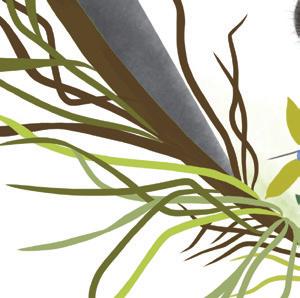
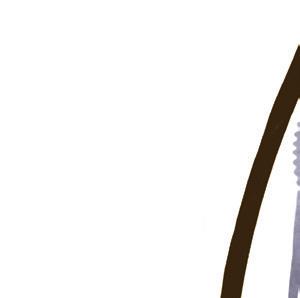
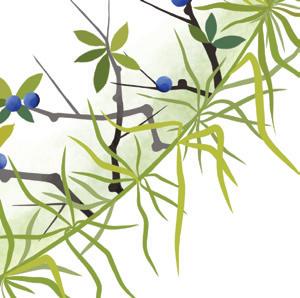







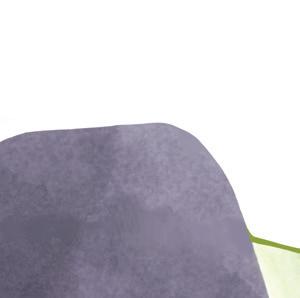



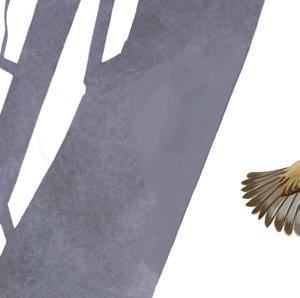


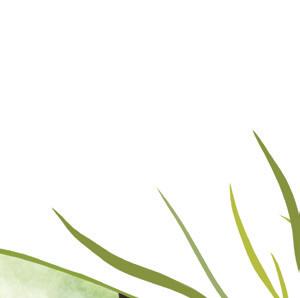
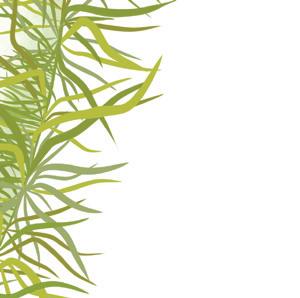
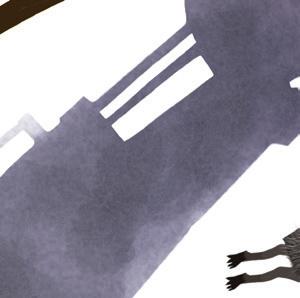


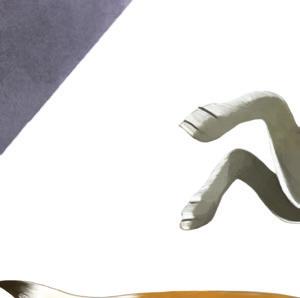
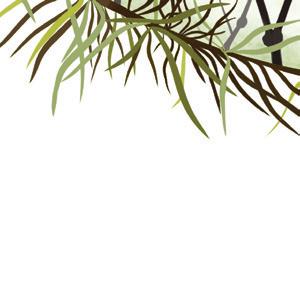
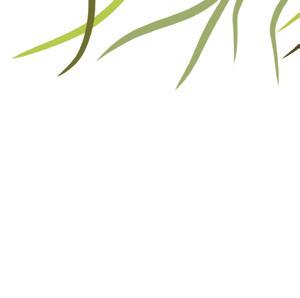
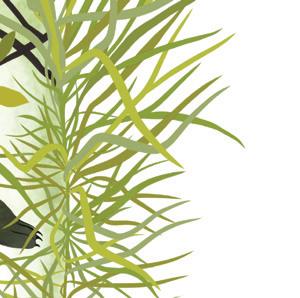

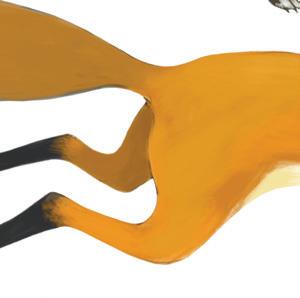
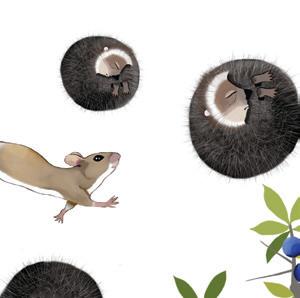
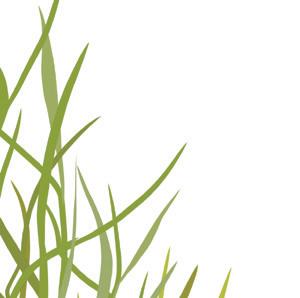
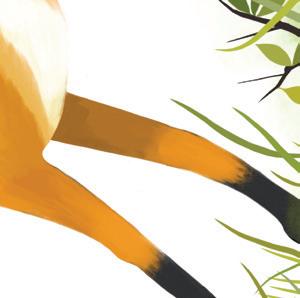
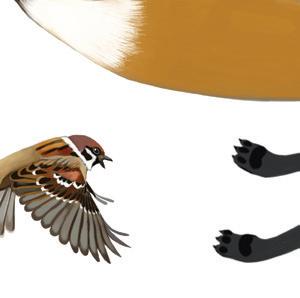



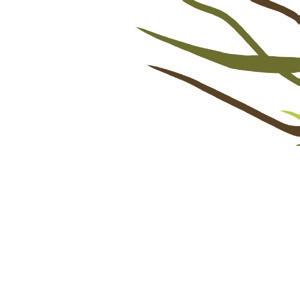
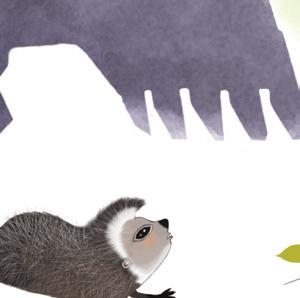


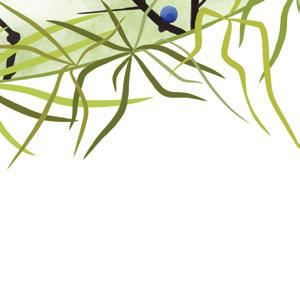
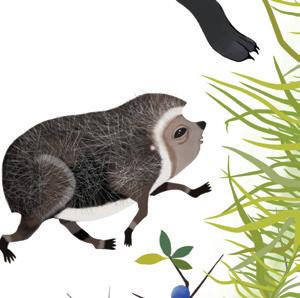

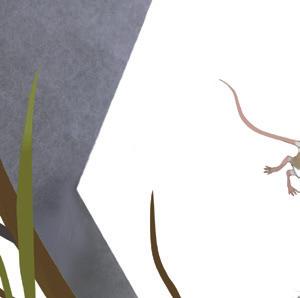




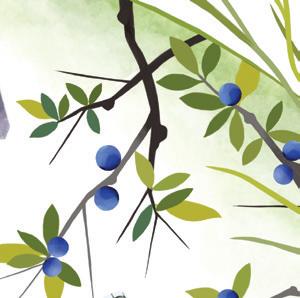
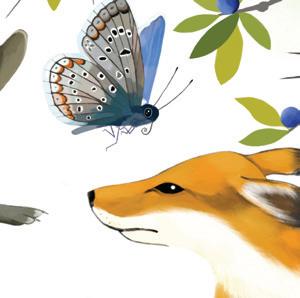
Listen. Underneath the hum of motors, the swoosh of tra c, the incessant chatter and clatter of our busy lives, there is an unnoticed absence. A strange unfamiliar sound on the earth: silence.
e earth, our shared home, is falling quieter by the day. Our non-human kin are leaving us. e millions of miraculous creatures we are supposed to be sharing this ball of life with, are disappearing. Humanity has wiped out 69% of all wildlife since 1970, and 75% of
START AT HOME AND BE THE CHANGE WE NEED TO SEE IN THE WORLD. BUILD AN ARK – AN ACT OF RESTORATIVE KINDNESS TO THE EARTH.
insect populations have been decimated. To the edge of a cli we have driven them and o en over it, never to return.
Mostly all of us are suffering from a phenomenon called ‘Shifting Baseline Syndrome’, where every passing generation has no memory of what ‘natural’ used to be. We just accept the current depleted version of the earth as being what nature has always been. is is the Great Forgetting. e oceans used to be crystal clear, kept that way from the massive beds of oysters on the sea beds and the waves used to be visibly heavy with life. e skies used to darken when the sun was blocked out by ocks of birds or butter ies passing overhead on one of their heroic migrations. Now we get excited when we see one individual. e whole skin of the earth used to move with
Irish Wildlife Winter '22 16
FEATURE
life, heaving with vast cities of creatures. Our land was covered with a full set of clothes, a diverse network of native woodlands, wetlands, prairies, and glades where a myriad of creatures made homes. Humans lived within this abundant system with awe, respect and compassion for thousands and thousands of years (and many still do in parts of the world). We lived in full awareness that if we took too much for ourselves or began to treat living beings as commodities, we would find ourselves in the wasteland. But we lost our way. And now here we are. Eking out an existence in the wasteland, living at the edge of a cliff ourselves.
The only reason we get to live here on this magical, abundant paradise that we call ‘Earth’, is because the planet continues to support us with clean air, water and food. The earth is a living organism, made up of millions of species all working together in harmonious and often mysterious ways. These are the threads in the web of life. They support each other, control each other, nourish each other. Each of these threads that we remove in our efforts to continue to grow exponentially and expand our interests and greed, has a knock-on effect on the rest of the web. We do not know when we will finally remove a thread that is holding it all together.
Most of humanity has ignored the consequences of our actions for too long. We live in a crazy system of constant expectations of economic growth in a world with finite resources. Politicians cannot be trusted which should be obvious after years and years of broken promises, blatant lies and shiny, green spun photo opportunities. They have had too many chances and it is now clear that the birth of a new world is up to us to imagine. This ship is visibly sinking and they are still fighting over what colour the lightbulbs on the deck should be. This is not something that will only affect future generations. This is happening right now. The collapse of nature leads directly to a collapse of society and those noisy but wonderful two-legged creatures called humans will fall silent too.
But there is hope, these systems can change, but only from the ground up. The direction our world is heading is not controlled by people so much as systems of behaviour that are established and adopted over many years. Together we can build new systems that lead to different outcomes. We must all become the leaders we are missing and if we want to save the planet, we must start with our own patches of it.
These places we have taken for ourselves,
without a thought for the creatures that called them home, they are broken and barren, emptied of sound, of movement, life, health and magic.
Gardens are green deserts for our shared kin. It’s time to convert our gardens into Arks and become part of the solution instead of greenwashing ourselves into believing we are helping, by gardening. Generally, we are not, despite what the gardening industry would like you to believe.
Creativity is a vital part of human life, but we have got to learn how to be creative without causing damage to nature. It’s time to learn to share. Not everyone is lucky enough to have some land under their care, but even creating a wild window box full of native plants and other supports will be a

FEATURE Irish Wildlife Winter '22 17
"THE ONLY REASON WE GET TO LIVE HERE ON THIS MAGICAL, ABUNDANT PARADISE THAT WE CALL ‘EARTH’, IS BECAUSE THE PLANET CONTINUES TO SUPPORT US WITH CLEAN AIR, WATER AND FOOD"
Mary Reynolds















Irish Wildlife Winter '22 18 FEATURE
welcome stopover service station for our beleaguered birds and insects in the vast food deserts we have created for them.
We are the Ark is a grassroots movement of people, committed to giving at least half of their patches of this planet, their gardens, back to nature. If not half, as much as they can manage. ese are acts of restorative kindness to the earth. This is a movement that converts gardeners into stewards, and toxic, forgotten land into living sanctuaries. Little pieces of earth on every continent are already being carefully returned to their original residents. Families, in fact whole interconnected neighbourhoods of creatures, are invited and allowed back to establish permanent residency. All kingdoms are included. A reconnection with nature and a remembered love for the earth is restored.
WE ARE THE ARK:

• Invites people to restore native plant communities as the foundation stone of all working ecosystems. Working with the native seed bank and native plants of local provenance (if possible) in their gardens, window boxes, parks, and public land. Removing any non-native plants, especially the invasive ones. Any patch they can give back, to create a patchwork quilt of sanctuaries that wraps its way around the globe.
• Empowers people to give land back to nature and guides them through the transfer process. To acknowledge the missing threads of life that keep an ecosystem healthy, and to step in and “become” the wolf, the deer, the missing creatures, and the services they provide. On a simple level this means creating as many di erent layers of ecosystem maturity as possible; from bare earth patches, to grazed grassland, meadow, scrub, woodlands and all the supports we can provide in between. All the life is



in the edges so as many di erent layers as you can t on your patch. All help is welcomed and encouraged.
• Aims to allow and support connectivity between these Arks, especially focusing on protecting the vital ancient woods, hedgerows and trees that are being lost at the rate of knots.
• Asks people to grow their own chemical free food in the rest of their land if they are able, share land with friends and neighbours to do the same, or support local, organic, regenerative producers and farmers. To stop supporting the industrial farming, shing and forestry systems which are largely causing the collapse of nature.

• Provides lots of ideas for extra creature supports, directions to create as many di erent habitats as possible in their Ark.
• Asks people to erect a homemade sign for neighbours and passers-by, saying “This is an ARK – An Act of Restorative Kindness to the Earth” to remove the ‘shame’ of having a notso-tidy (simple versus complex) garden, to inspire others to join the movement.

Humans have taken too much. It is time to thoughtfully open our gardens, parks, waterways, and farming corridors to nature, to let her breathe. is has already become a global patchwork quilt of hope. e earth needs to rest and heal. To become her true nature again. As do we. Every patch of land that nature restores to sustainable balance becomes part of a much needed groundswell of living diversity on which our very survival depends. ese Arks will become the seeds of restoration, living islands of patient hope, of belief in our future.
Fall back in love with nature by setting your land free and being amazed and enchanted by the wonder of the wild creatures, rooted and un-rooted that turn up almost overnight. It is as if the earth calls them in saying “ ere is safety and sanctuary here. You are home”.
Become a guardian, not a gardener and let natures noisy voice soothe our souls once again.
Mary’s new book, We are the Ark is out now. See our competition page for a chance to win a copy.
FEATURE Irish Wildlife Winter '22 19
"IT IS AS IF THE EARTH CALLS THEM IN SAYING “THERE IS SAFETY AND SANCTUARY HERE. YOU ARE HOME”
BY ALI NORMAN
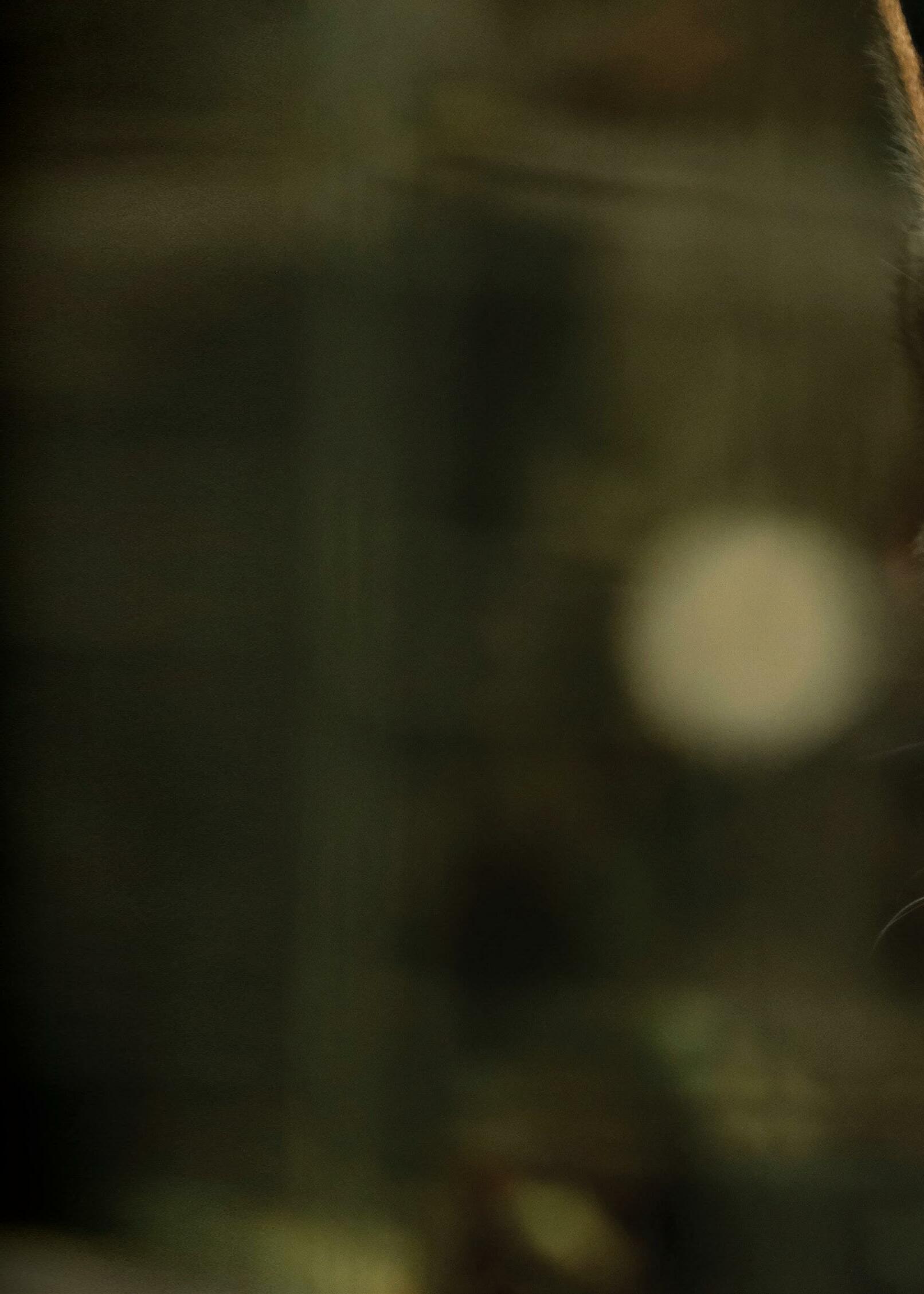
Rewilding is a word that gets thrown around a lot these days, in many di erent contexts. In general, it is a way of turning land back to nature and promoting ecosystem function. From local town councils letting grass verges grow, to large scale predator reintroduction projects, rewilding means di erent things depending on who you talk to. For some it is even interpreted as a shift towards ecocentrism and reconnecting people with nature. ere are multiple de nitions and interpretations of rewilding and what can be carried out in its name. Unfortunately, this can sometimes lead to problems.
Misunderstandings around rewilding can create friction between groups. Picture two people conversing about rewilding. e rst, says they want to rewild an area, in the sense that human management should be reduced. e second, however, might interpret this as a plan to release wolves, and might not be fully onboard. And if neither individual address what they mean by rewilding, this can snowball into a much bigger argument. Such confusion around the term slows the introduction of rewilding into policy and practice and prevents appropriate scientific reviews of rewilding as a technique.
So, to have more constructive discussions about rewilding, we first need to understand what people mean by the term. And this is where my research project comes in. To begin to understand rewilding better in an Irish context, I did a preliminary study across the environmental sector to assess their perceptions of rewilding and explore what this means for the future of rewilding in Ireland.
Overall, we saw a lack of consensus around the speci cs of what rewilding entails. We know the overarching goal: rewilding is about restoring lost natural processes and ecosystem functions and promoting biodiverse self-sustaining habitats. But how we go about doing this is where the confusion lies, centred on three major areas: the importance of
RE WILD ING PERCEPTIONS:


a term posing a lot of questions
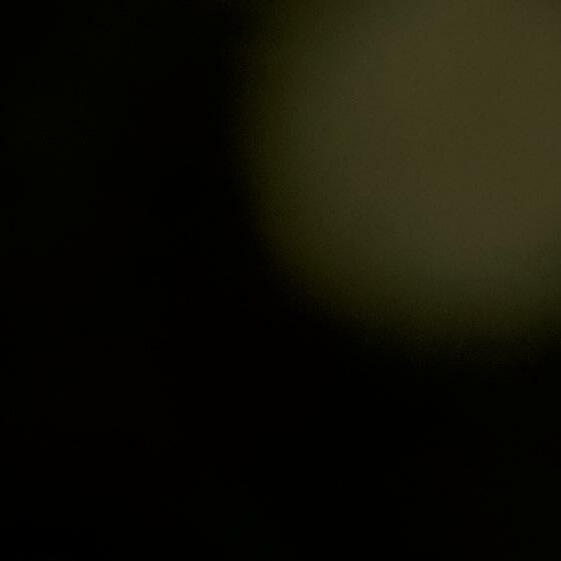
animal introductions, the scale required for rewilding, and how much human management is required.
There was consensus about the relationship between people and rewilding, with a lot of emphasis throughout that rewilding does not mean excluding people from the land. Agriculture, ecotourism, and rewilding can co-exist. Successful rewilding must be built on partnerships of bottom-up, community led movements. However, human inclusion in a space does raise the question of what it means to be wild and even what wilderness means in an Irish
context. Similar to rewilding, wild and wilderness are subjective terms. A better understanding of public perceptions of wild is therefore an integral part of the rewilding conversation.

Moving forward with rewilding there are two options. Firstly, the argument has been made for the term to be dropped. Has it become an “unusable buzzword” that has been “hijacked by businesses”? Is it all “sensationalism about rewilding wolves”? Is it too “polarising” and “toxic”?
Or should we embrace the nuances? Rewilding is an umbrella term, but at its core, it is about promoting biodiversity
Irish Wildlife Winter ‘22 20 WILD IDEAS
and healthy functioning ecosystems. As one participant put it, a “nuanced and flexible definition of rewilding is the future”. Perhaps the looseness of the term allows it to be used more widely and bring people on board in different ways. There is a reason it has become such a buzzword; people connect to it; people like it. Rewilding is a popular term, whether we want it to be or not.
This does raise more avenues for research, with a similar study needing to be carried out across the wider public, and a perception of wild and wilderness study done with this. This preliminary study

Is rewilding about reintroducing predators such as lynx?
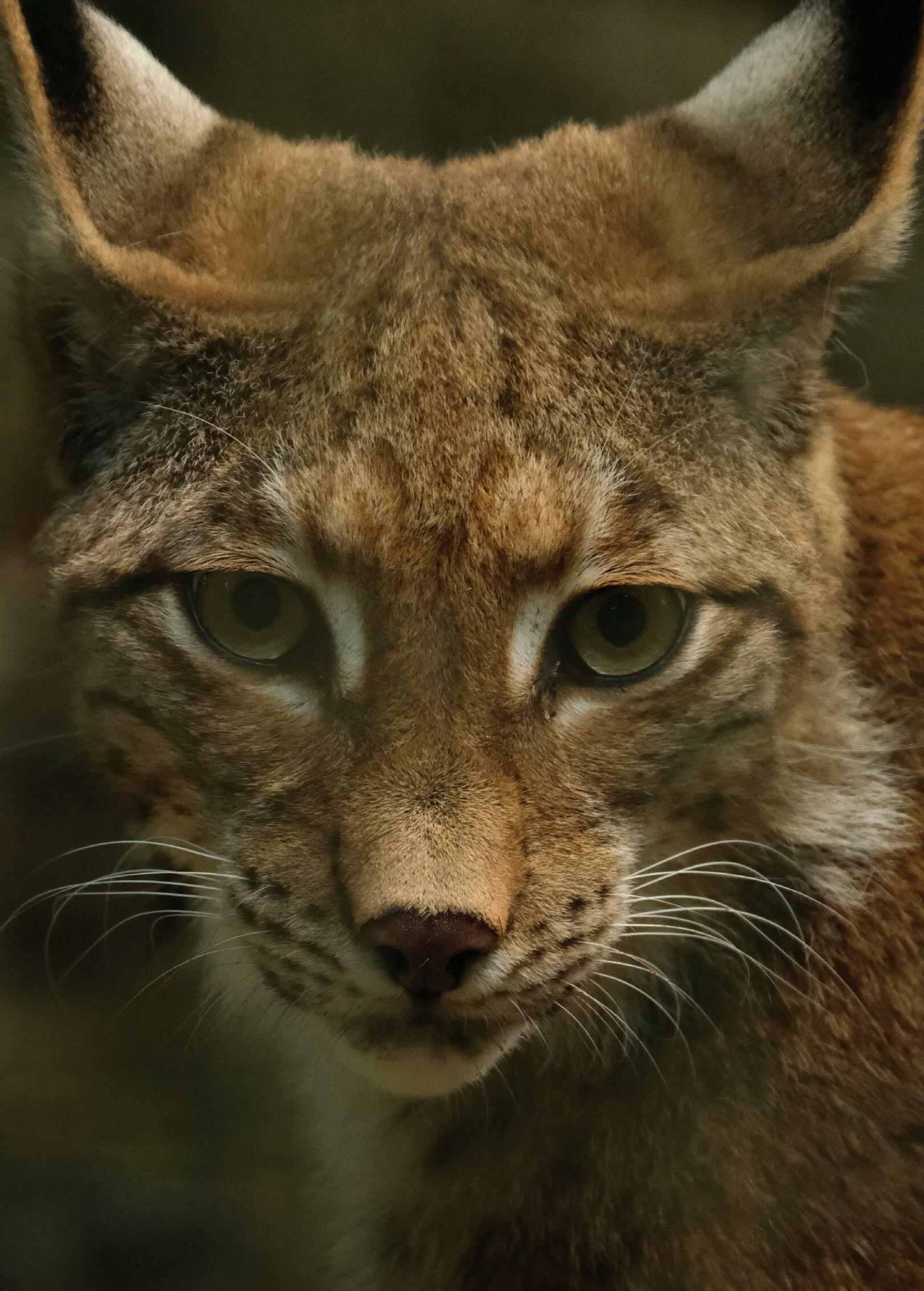
Is rewilding about reconnecting ourselves to nature?
only looked at a small number of people in the environmental sector, and as such is only a narrow view. A more comprehensive understanding of rewilding in Ireland is needed.
We must also highlight that rewilding has many interpretations. This does not mean we have to retire the term, but we do need to be cautious when using it. Any person or project using the term, needs to be clear on what they mean by it. A proactive communication strategy is vital to reduce confusion and build successful rewilding projects.
Rewilding has the potential to be a powerful tool in conservation. But only if we work to get it there. We are in a sixth mass extinction event. The biodiversity crisis is undeniable. Is it right to throw out a tool just because it can be a bit complicated? Rewilding is an evolving term, and we should not try to limit its use. Instead, we need to understand the different views without constraining them and build on the nuances of rewilding to put in place where possible.
Ali is a passionate environmental advocate who has just finished her master’s degree in Environmental Leadership with a thesis focused on rewilding.
WILD IDEAS Irish Wildlife Winter ‘22 21
"WE KNOW THE OVERARCHING GOAL: REWILDING IS ABOUT RESTORING LOST NATURAL PROCESSES AND ECOSYSTEM FUNCTIONS AND PROMOTING BIODIVERSE SELF-SUSTAINING HABITATS"
Wildlife Origins
WHAT’S TO BECOME OF OUR WILDLIFE?
 BY GORDON D'ARCY
BY GORDON D'ARCY
Away from the demands of outdoor events and fieldwork, the winter is a great time for reflection. Questions come to mind, stimulated by environmental pressures and demands of a growing, fast moving population. How do we see the future of wildlife in this country? Is the conservation message well established among people at large or will we continue to rely on the strictures of the European Union to protect our biodiversity and the habitats they must have, to thrive? Though the many Special Areas of Conservation and Special Protection Areas
constitute a vital mosaic of protectorates what about the numerous, but often overlooked, local reservoirs of biodiversity? Wildlife corridors, whether linking habitats on a local or political basis are essential for the wellbeing of nature that does not recognise boundaries. That it can be done with cooperation among disparate groups including naturalists, local residents, community activists and politicians has been demonstrated in the creation of the Terryland Forest Park, a marvellous wildlife corridor extending from the boundary to the heart of Galway City.
With 40% in a substandard condition, the recent Environmental Protection Agency report on our rivers and lakes makes for sad reading. Run-off pollution from agriculture and domestic sources is again cited as the main problem. Will new farming initiatives combined
Irish Wildlife Winter '22 22
GORDON D’ARCY
Strawberry tree by Zoe Devlin
with more rigorous domestic effluent control, backed by EU pressure, eventually bring Ireland’s waterways to a better place?
Whatever about the implementation of conservation legislation, the condition of our natural habitats – whether terrestrial or aquatic- will remain an inescapable issue for future generations of nature lovers.
Change is the great imponderable. Looking back at the relentless manner in which our wild places – forests, wetlands, bogs, etc. – have been radically altered by human activity, it’s a wonder that representative habitats remain. It’s an even greater wonder that remnant flora and fauna have endured: the various Arctic/Alpine plants; a trio of endemic mammals and a few bird species, for instance. In contrast to this continuity, are the losses – wolf, wildcat, wild boar, a dozen or so birds that we know about and numerous unrecognised invertebrates and plants. The return of the great-spotted woodpecker, the buzzard and (most recently) the crane, however, has shown that change is often a two-way phenomenon.
Ireland’s natural history is far from being unique. A major characteristic of islands is species ‘turn-over’ and indeed, extinction. Such biogeographical instability is a feature of many similar sized islands throughout the world. Theories abound as to the arrival and departure of species. The late Prof. Mitchell’s westward ‘steeple-chase’ theory for the arrival of species in Ireland (substantially fewer than our neighbouring island), based on the natural obstacles of the English Channel, the Pennines and the Irish Sea, is no longer regarded as an adequate explanation. Modern scientific investigation points to incursion from the south, for many species. Post-glacial ‘refugia’, temporary islands (vanished due to sea-level rise) to the south of Ireland are now suggested as more likely avenues of incursion.
While biodiversity fluctuations have always been attributed to man’s activities, modern advances in dating processes and genetic sequencing have enabled a clearer picture to emerge. Currently ‘revisionism’ is concentrated on the well-documented Lusitanian flora and fauna. Formerly, this suite (a number of rare plants, the Kerry slug, natterjack toad, etc.) were regarded as unaided post-glacial arrivals to Ireland. A startling alternative has been mooted, however, based on recent botanical investigations carried out by Micheline Sheehy Skeffington and Nick Scott (and published in the journal British & Irish Botany) into the provenance of the arbutus or strawberry tree (which grows wild in County Kerry). According

to the theory, the tree was brought to Ireland by copper miners from northern Spain, during the Bronze Age. An impressively detailed investigation including genetic sequencing presents a convincing argument. Do we therefore need to revise our attitude to the role of humans as vectors of wildlife transportation to and from Ireland?
The issue of wildlife distribution also presents anomalies which may involve humans. The yew tree, once widespread as indicated by the many associated place names, has nowadays a restricted range, surely due to it being poisonous to cattle. In this case the influence is unambiguous. But what about the current range of the windseeded Arctic/Alpine mountain avens. This plant is entirely absent from the Aran Islands despite being ubiquitous on the nearby Burren. Was it, as has been proposed, once present, but due to a paucity of alternatives, grubbed up for use as fuel? One of the most puzzling distribution cases is that of three of our resident butterflies – the pearl-bordered fritillary, the brown hairstreak and a wood white – confined to Ireland’s mid-west region, far removed from their south of England range in the UK. Are the west of Ireland populations remnants of a once wider range or has there been an indirect human-involved explanation in their distribution?
In a world of ever-expanding links, where change outpaces continuity, where genetics casts new, often unexpected, light on the investigative process, do we need to revise our ideas about what we actually consider Irish wildlife to be- or become?
GORDON D’ARCY Irish Wildlife Winter '22 23
"CURRENTLY ‘REVISIONISM’ IS CONCENTRATED ON THE WELLDOCUMENTED LUSITANIAN FLORA AND FAUNA"
Natterjack toad by P. Fogarty
WASTEWATER TREATMENT
– NOT GOOD ENOUGH!
 BY BILLY FLYNN
BY BILLY FLYNN
As we approach the end of the year, it gives us a chance to look back and reflect on the state of the environment and what progress we might have made. In the light of recent information and a steady stream of gloomy and foreboding reports, you’d hope that we have cause to be optimistic that we are turning things around. Indeed, a recent (October 2022) review of Ireland’s wastewater treatment in 2021 reports progress in terms of how we are treating our surface waters. However, some of the details therein do not give us much to cheer about.
The Environmental Protection Agency’s (EPA) report, Urban Waste Water Treatment in 2021, describes how the billion or so litres of water that we discharge to public sewers is treated and how this stacks up against the standards that have been set for the protection of the watercourses and waterbodies into which the treated water is eventually discharged. Irish Water is the national water utility that is responsible for providing this service and the EPA is essentially the watchdog that keeps track of how Irish Water is doing in terms of environmental standards and impacts.
The EPA report identifies five key issues, a set of environmental priorities, that Irish Water must address to protect our environment from potentially harmful effects of the wastewater that is discharged. It sets these out in terms of the urban areas where standards are not being met, non-compliant sewers and areas where environmental sensitivities make improved treatment a priority. In all, these amount to some 98 areas and are summarised in the table, on page 23.
There is good news in this report. Of the 174 large urban areas that are subject to the EU wastewater treatment standards, 162 areas were compliant. While this still leaves 12 areas where standards were not met, this is down from 28 non-complying areas in 2017 and 19 such areas in 2019.
So, we are headed in the right direction, it would appear. However, on the downside, nearly half of all of Ireland’s wastewater is generated in these 12 non-
compliant areas. This cohort includes the greater Dublin area where the overloaded Ringsend treatment plant cannot discharge properly treated effluent. Large urban centres in Co. Cork including Cobh, Ringaskiddy and Clonakilty also contribute to the offending discharge list. It should be said that works are underway at all of the larger centres to bring their discharges into line. Last year, major works in Cork and Ennis brought these within the compliance bracket for the first time. Alarmingly, a total of 32 towns and villages discharge raw (completely untreated) sewage into our rivers and seas, enough to fill three Olympic size swimming pools every day. New wastewater treatment plants and connections to existing plants are desperately needed in such areas as Ballycotton (Co. Cork), Ramelton (Co. Donegal) and Foynes (Co. Limerick). The swiftest glance at the National Parks and Wildlife Service’s database of protected sites shows Special Areas of Conservation (SAC) and Special Protection Areas in the direct firing line in these sensitive locations. While Irish Water

Irish Wildlife Winter '22 24 WINTER FOCUS
"32 TOWNS AND VILLAGES DISCHARGE RAW SEWAGE INTO OUR RIVERS AND SEAS, ENOUGH TO FILL THREE OLYMPIC SIZE SWIMMING POOLS EVERY DAY"
project that all of these offenders will be brought into line by 2027, that is another five years of ongoing damage, day in, day out.
In terms of risks to our surface waters (lakes, rivers and coastal waters), Ireland’s draft third cycle River Basin Management Plan (2022-2027) identified wastewater discharges as a significant pollution pressure on 208 water bodies. This represents an improvement on the 291 water bodies thus identified in the previous cycle (2018-2021). Rivers are the most affected of the water bodies with the River Suir (SAC) and River Barrow (SAC) potentially suffering from insufficiently treated discharges.
One of the most endangered species in Ireland – the freshwater pearl mussel – is in decline and for the most part, this is down to poor water quality. The EPA has identified 12 towns and villages where improvements are needed in order to protect vulnerable freshwater pearl mussel populations. This has not improved over
Environmental Priorities Priority Areas
Ensure wastewater treatment at all large urban areas complies with European Union standards

12 large urban areas that did not meet EU treatment standards in 2021 require improvements
Eliminate discharges of raw sewage 32 towns and villages discharging raw sewage into the environment every day must be connected to wastewater treatment plants
Upgrade collecting systems noncompliant with EU requirements Six collecting sewers must be upgraded
Improve treatment to protect inland and coastal waters that are adversely impacted by wastewater
38 priority areas require improvements to protect rivers, lakes, estuaries and coastal waters that are adversely affected by wastewater
Improve treatment, where needed, to protect the freshwater pearl mussel 12 areas need improvements in wastewater treatment to protect the freshwater pearl mussels
the year since the last EPA assessment of these areas. However, the EPA report does describe improvements in three of these areas although monitoring hasn’t provided enough evidence to back this up. There are five areas where no plans at all have been set out to show how things will improve for this critically endangered species.
While the report certainly shows improvement, there is clearly room for much more. At time of writing, Irish Water had not clearly identified when and how improvements will be made in one third of the priority areas described above. As a nation, we have taken this precious national resource for granted and misused it as a matter of routine. The continued discharges of completely untreated sewage are impacting watercourses that are protected (at least on paper) for wild species and their habitats. We know that climate change is going to put additional pressure on our water supplies and waterdependent ecosystems with each passing year. The necessary improvements can’t come soon enough.
Dublin Bay continues to suffer the effects of poorly treated sewage

WINTER FOCUS Irish Wildlife Winter '22 25
The recently completed Inishannon Wastewater Treatment Plant. Photo by Jason Nash
NATURAL HISTORY OF ONE OF OUR MOST COMMON BIRDS
the Rook Ode to

Irish Wildlife Winter '22 26
BY RICKY WHELAN
The rook is among seven species in the Corvid (or crow) family that are native to Ireland. The Corvid family is made up of what we might consider the true crows (genus Corvus) as well as the magpies, jays and nutcrackers. In no particular order that list of seven “crow” species includes: jackdaw, chough, rook, hooded crow, raven, jay and magpie. Remarkably the corvids are considered passerines (songbirds), but they are unlikely to win any plaudits for their raucous songs and calls. The rook is by far the most common, numerous and widespread of them all with recent population estimates in Ireland of 3.5 million individuals.
The scientific name for rook is Corvus frugilegus, the “Corvus” bit meaning crow and the “frugilegus” meaning “fruit-gathering”alluding to their foraging preferences for vegetative material which may surprise those amongst us who think they live off scraps from bins alone!

The rook is a large crow, robust, with handsome black inky plumage, grey legs and feet, and a large grey bill with a bare patch at the base. They are highly social, almost always in groups, sometimes in small family groups or more often in their hundreds grazing in newly cropped fields or perched in long rows along electricity lines. Young rooks have a black bill and lack that bare patch at the base, which comes after a year or two and is typical of adult birds. This bare patch acts to allow rooks to drive their powerful bill further into the soil to find invertebrate prey such as “leather jackets”, the larva of craneflies (daddy long-legs).
Rooks, like other crows, are highly gregarious, nesting in colonies known as rookeries and coalescing into large flocks in the autumn and winter, spending the night at communal roost sites in trees that can be thousands of birds strong. Rookeries are large communities of nests and adult pairs living and rearing broods close to neighbors, but they do protect a small territory of mere inches around the nest and the male of the pair will stand guard on a perch beside the nest when he’s not out foraging
on behalf of himself and his mate. Rooks, and indeed all crows, are single brooded so once the nest of young has fledged the family will move to join other family groups from their rookery and as breeding season comes to a close, and the autumn arrives, these flocks grow larger. These flocks afford protection, provide heat at roost, where pair bonds are formed and information is shared.
Winter roosts form in stands of trees and can exist at the same site for many decades. Social status is exerted at roosting time and rook societal rules are followed. When the birds arrive back as darkness approaches, they will begin to settle on the limbs of the trees, the young subordinate birds on the lower branches, older birds further up and the dominant pairs at the top. This stratification is very much by design, as information flows upwards with the alpha birds filtering the best tips on food sources/locations etc., whilst their waste flows downwards, it’s clear to see why the top branches are the desired perches. In a cruel twist for young birds at these roosts, during adverse weather the dominant birds will take the lower branches and allow the subordinates to act as feathered umbrellas! It really is advantageous to have status among crows.
The rook doesn’t often get the appreciation it deserves but in Laois the Irish Wildlife Trust, BirdWatch Ireland and the local authority have been on a bit of a campaign to boost local knowledge and appreciation for these humble creatures. In early spring this year (2022) the Laois Rookery Survey was initiated through a simple social media campaign. A citizen-science project, supported by the National Parks and Wildlife Service Small Recorders Grant, asked for folk to submit the location, approximate number of nests, and tree type (if known) of their local rookeries. And the response was massive! In just a couple of weeks, 173 unique rookeries were identified numbering from 5 to >250 nests each distributed widely across the county. The largest rookery containing 253 Apparently Occupied Nests (AONs) occurring in Portlaoise town center. The study showed the importance of urban
PhotobyAgaGrandowicz
CITIZEN SCIENCE Irish Wildlife Winter '22 27
"THE ROOK IS A LARGE CROW, ROBUST, WITH HANDSOME BLACK INKY PLUMAGE, GREY LEGS AND FEET, AND A LARGE GREY BILL WITH A BARE PATCH AT THE BASE"
areas for nesting rooks as well as their preference for open pastures with no rookeries being identified in the upland and forested areas of the Slieve Bloom Mountains, for example. Plans are afoot to now try to identify the important winter roost sites within the county which grow to their largest between November and February.

With the energy and enthusiasm of the rookery survey behind us we decided to run a rook and batthemed event for National Heritage Week during August. Irish Wildlife Trust LaoisOffaly Branch, Kildare Bat Group and BirdWatch Ireland together with the Laois Heritage Office hosted the “Bats About Rooks” event in Portlaoise’s Peoples Park. Attendees were treated to the whole nightly drama of the rooks as they arrived to roost and sorted out the pecking order. With the rooks settled, the bats came into their own and Kildare Bat Group gave a wonderful tour of the bats and habitats within the park. As luck

would have it, we managed to win the Biodiversity Award at the recent National Heritage Week Awards for that event!
Finally, after a long break from in-person and practical events and projects during the pandemic, the IWT Laois-Offaly Branch are again working with Laois Heritage Office and the community in Timahoe to improve and promote the rich natural history of Timahoe Monastic Site in the middle of this picturesque village. As part of that project, we will be highlighting the rookery and the charisma of the birds on site through wildlife interpretation and through the onsite museum. This work included commissioning wildlife illustrations by Aga Grandowicz (agagrandowicz.com).
Irish Wildlife Winter '22 28 CITIZEN SCIENCE
"AS PART OF THAT PROJECT, WE WILL BE HIGHLIGHTING THE ROOKERY AND THE CHARISMA OF THE BIRDS ON SITE THROUGH WILDLIFE INTERPRETATION AND THROUGH THE ONSITE MUSEUM"
Ricky Whelan talks rooks at the Bats About Rooks event in Portlaoise.
Photo by Alf Harvey
Laois Rookery Map
Ainmhí beag mistéireach an cat crainn
Kate Mac Lochlainn
Faoi chosaint faoin tuath, ach crá mór i dteach príobháideach.
Nuair a d’oscail muid doras ár dteach saoire agus chuamar isteach sa teach, bhí uafás orainn ag an radharc a bhuail ár súile.
Bhí carnáin de shalachar dubh i ngach áit: leagadh réada de na seilfeanna agus iad briste ar an urlár: baineadh úsáid as ár gcanú beag mar leithreas, le linnte fuail bhréan; bhí na seomraí loitithe agus na leapacha millte.
Ar dtús, shíleamar gur mionc ab iad na cuairteoirí seo gan chuireadh, ón gcanáil in aice láimhe;

ach ní raibh aon chnámha ná scálaí éisc le feiceáil i measc na praiseach.
D’fhéachamar ar na crainn péine thart
timpeall agus tháinig sé chun solais go raibh ár dteach ina gharbhán máthar do theaghlach cait crann.
Níorbh fhéidir linn a dhéanamh amach conas a fuair siad iontráil - ach creidim anois gur dhreap siad anuas an simléar, cosuil le Daidi na nollag!
Is créatúr go leor rúndiamhra é an cat crann: agus ceann de na mamaigh is áille againn freisin.
Tá sí an-dathúil, le fionnaidh álainn donn agus geal, cosuil le uachtar agus seacláid; míníonn sé seo an fáth seilgeadh siad dona gclúmh ar feadh na gcéadta bliain, agus a gcuid fionnaidh in úsáid le haghaidh éadaí ríoga, nó le honnmhairiú.
Stop an trádáil seo sa 20ú haois, ach
bhí bagairt nua le feiceáil; nimh á leagan ag feirmeoirí, chun an trádáil chaorach nua-bhrabúsach a chosaint.
Go deimhin, thógfadh sé cat-crann ancróga uan a bhaint, ach ní bhíonn faitíos i gcónaí réasúnach! Agus tá sé fíor go leor gur féidir leis na sealgairí beaga cróga seo go leor damáiste a dhéanamh i dteach cearc.
Bhuel, tá sé sin nádúrtha - is iad na crainn gnáthóg dhúchasach an speicis: agus is cuid dá réim bia nádúrtha éin agus uibheacha de chineál ar bith!
Ní hiad na héin an t-aon rud a itheann an cat crainn, áfach - tógann siad pé rud a chasann orthu;
Cé gur feoiliteoirí iad, itheann siad gach saghas bidh..
-- ábhar ainmhithe agus plandaí araon, lena n-áirítear mamaigh bheaga, éin, uibheacha, amfaibiaigh, inveirteabraigh, caora, torthaí, fungais agus carran.
Iosfaidh siad a bhfuil flúirseach go háitiúil, lena n-áirítear bia a fhágtar amach do pheataí agus éin, agus fiú bia daonna ó bhoscaí bruscair.
Dúcheist eile: cén chaoi ar tháinig an cat crann ar ais chomh maith sin le blianta beaga anuas?
Faoi lár an 20ú haois, ba speiceas fíorannamh a bhí ann, nach bhfuarthas ach i gcúpla limistéar iargúlta ar nós na Boirne. Ceaptar gur chabhraigh leathadh na bplandálacha buaircíneacha lena líon teacht chucu féin - agus ag an am céanna, tá líon na n-iora glas ionracha ag dul i laghad de réir mar a thosaigh an cat crainn agus an t-iora rua dúchasach ag téarnamh!
Níl aon mhíniú agam ar an ainm “cat crann”. Ar ndóigh, tá cait intíre le fáil in Éirinn ach níl siad dúchasach, cé go bhfuil go leor acu imithe i bhfiáin. Agus iad ar fad in ann crainn a dhreapadh agus éin a ghlacadh!
Nuair a bhíonn an focal “cat” le feiceáil i logainmneacha Gaeilge ar nós “Oweynagat” (Uaig na gcat) is dócha go dtagraíonn sé do chait na gcrann.
Agus rúndiamhair deiridh; conas na créatúir bheaga a choinneáil amach as mo theachín roimh an Earrach seo chugainn…
Sreang sicín thar an phota simléir, sílim!
FIADHLÚRA Irish Wildlife Winter ‘22 29
https://pinemarten.ie/the-pine-marten/
An cat crainn ó Mike Brown
REWETTING and the Peatland CLIMATE
BY DAVID WILSON
Since the end of the last Ice Age, peatlands have played a major role in the regulation and maintenance of the global climate. Natural (undamaged) peatlands act as long-term sinks for carbon dioxide but are also sources of methane (a strong greenhouse gas), and it is this interplay in gas exchange over millennia that has led to the storage of vast amounts of carbon within peatlands and organic soils during this time. The removal and storage of carbon by peatlands has had a cooling effect on the climate and recent estimates suggest that approximately 600 billion tonnes of carbon are locked up in peatlands globally, with 2.2 billion tonnes held in Irish peatlands alone 1
Key to this role is the position of the water table within the peat, with the optimum level from a carbon perspective likely to occur when the water table is close to the peat surface. This wet environment prevents the easy decomposition of leaves, stems and roots of peatland plants, which then accumulate over time and form the basis of peat. On a dry matter basis, peat contains approximately 40–50% carbon, and can extend to over 10 metres depth in some of our raised bog remnants.
Drainage results in a radical transformation in peatland carbon exchange; former carbon sinks can rapidly switch to large sources as the peat is rapidly decomposed by oxygen-loving microbes, resulting in a warming effect on the climate. In Ireland, around 85% of peatlands have been drained for agriculture, forestry or peat extraction, and only a small proportion of peatland sites can be considered as active carbon sinks.

A case study from Moyarwood bog, Co. Galway
The premise that rewetting of drained or degraded peatlands can assist in climate change mitigation has gained considerable traction in recent years. Rewetting aims to reverse the hydrological changes brought about by drainage and to establish the requisite conditions for the (re) establishment of typical peatland plant communities. In some cases, rewetting may involve the blocking of drains only, while in others, more extensive management actions may be required.
To-date, research has indicated a strongly site-specific response to peatland rewetting, although very few studies have examined the long-term impacts of peatland rewetting on carbon exchange with the atmosphere. In our recently published paper in Global Change Biology2, we measured and modelled the movement (fluxes) of carbon dioxide, methane and nitrous oxide (all greenhouse gases) over a 5-year period in Moyarwood bog, Co. Galway. The site had been drained by Bord
Irish Wildlife Winter ‘22 30 FRONT LINE
Measuring gas exchange on the bog
na Móna in the 1980s with the intention to extract peat. However, site preparation did not proceed beyond these actions, and a vegetation cover remained in situ.
In 2012/2013, Bord na Móna installed peat dams in the drainage ditches across the 230-hectare site and in spring 2013, we commenced gas measurements in tandem with the monitoring of water table levels, soil temperature, phenology etc. We set up two study areas in the bog to determine the impact of rewetting: one area in the drained margin and the second in a newly rewetted area. Gas fluxes were measured with static chambers (polycarbonate “boxes” placed on permanent steel collars inserted into the peat before the start of the study). Over a 5-year period, gas measurements were taken in all four seasons with the aim to record the full range of light, soil temperatures and water table values that Moyarwood is likely to experience. Such long-term monitoring is essential to provide robust estimates of how an ecosystem will react to changes in weather and climate.
Our results showed that the drained marginal area was a large source of carbon dioxide emissions and a very small source of methane emissions throughout the 5-year study period. In contrast, the rewetted area quickly switched from acting as a carbon dioxide source to functioning as a very strong sink, in the process preventing substantial emissions to the atmosphere. However, methane
emissions surged strongly in the rewetted area, which may be due to inundation of the vegetation caused by drain blocking.
We then examined the impact of rewetting this peatland on the climate by modelling the data for the next 200 years.

Our model projections suggest that peatland rewetting at Moyarwood has already resulted in a reduced warming effect on the climate, compared to leaving the site drained. Moreover, our modelling indicates that the site will begin to have a cooling effect (similar to natural peatlands) on the climate after 2085.
Under the Paris Agreement, the goal is to limit the global temperature increase to below 1.5 oC. Peatland rewetting represents an important requirement for meeting the Paris Agreement commitments, although compliance will require that 50 million hectares of drained peatlands be rewetted globally by 2070. In Ireland, impetus for peatland rewetting has gained considerable momentum in recent years, and we hope that studies such as at Moyarwood will provide robust findings for landowners and policy makers.
David is an environmental consultant based in north Donegal. He can be reached at david.wilson@earthymatters.ie or on Twitter (@peatyGHG).

Irish Wildlife Winter ‘22 31
WILD IDEAS Peat dams holding water
Large
"THE PREMISE THAT REWETTING OF DRAINED OR DEGRADED PEATLANDS CAN ASSIST IN CLIMATE CHANGE MITIGATION HAS GAINED CONSIDERABLE TRACTION IN RECENT YEARS"
emerald
Tree planting ‘off setting’ and
BY ORLA NÍ DHÚILL
For those on the forefront of trying to protect ecosystems the rise in popularity of “carbon o setting” through reforesting might appear to o er new ways of funding their important work. It is an idea, however, that needs to be approached with caution. New organisations appear every day o ering more and more a ordable forms of o setting and many of them market themselves in wealthy countries and do their planting in developing ones where there is signi cantly less oversight. is can make it di cult to distinguish the genuine e orts from the scams. I looked at those organisations operating directly in Ireland the concept of o setting as a model for ecological restoration.
Carbon o setting claims people can compensate
for their emissions of carbon dioxide by paying others to either reduce emissions or absorb CO2. e most common form of o setting is tree planting. Healthy mature forests naturally absorb CO2 as they mature.
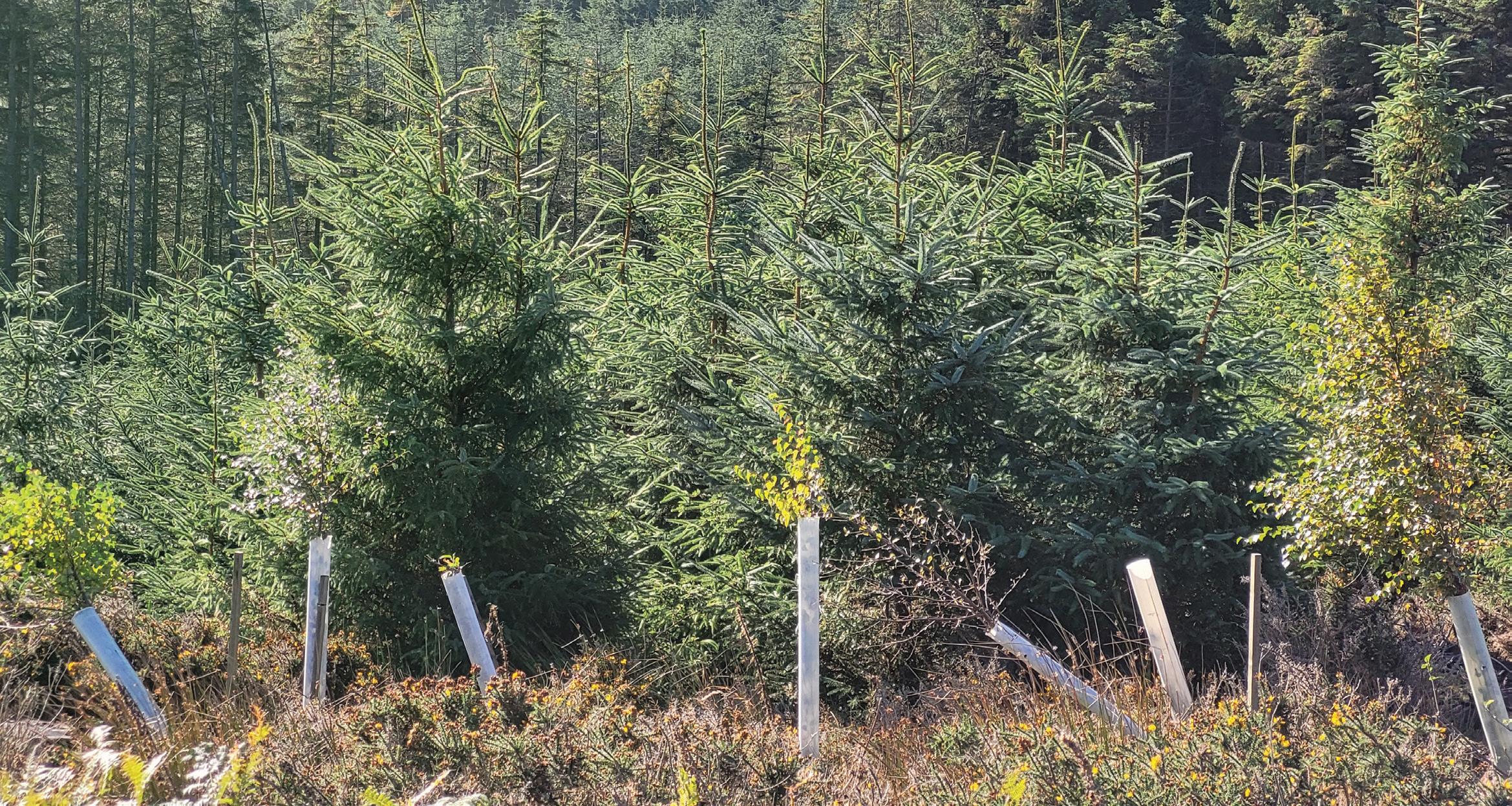
e process of capturing and storing carbon, like what happens in forests, is called carbon sequestration. e process of natural carbon sequestration in vegetation and the ocean has been disrupted heavily by human activities like pollution or deforestation or a vicious cycle of the knock-on e ects of climate change itself. is leads many people to see the o setting model as a win-win solution.
One major issue with this model, however, is that it allows fossil fuel companies or carbon-heavy industry to claim that they will be “carbon neutral” without meaningfully reducing the rate at which they emit. e climate altering e ects of “greenhouse gases” like carbon dioxide are brought on by those gases accumulating in the atmosphere and once they’ve been released, they’re staying there. Forests
Irish Wildlife Winter '22 32 TREE PLANTING
on the other hand, sequester carbon at much slower and less predictable rates. Every forest is di erent and the amount of carbon stored and the speed at which it can be absorbed is highly variable.



e second issue with the o setting model is longevity. Carbon released into the atmosphere remains there permanently, but forests only store carbon if they are allowed to mature and then protected from destruction. e average tree can take up to 20 years to capture the amount of CO2 that is usually advertised in these schemes. Very few of the projects plan for plant mortality or have su cient safeguards in place to protect and manage the site. A number of well-publicised wild res in 2021 destroyed vast areas of forest that had been planted for the purpose of carbon o setting.
e appeal of the simple solution is undeniable though and o setting has become crucial to the PR of many large emitters from BP and Shell to Heathrow Airport. In Ireland, there are about 14 prominent eco-branded organisations o ering tree planting services to individuals and companies that plant within the country.
Of those, half focus on mass tree planting as their main purpose or selling point, and another two use the language of carbon-o setting speci cally. Only three groups gave the protection or enhancement of biodiversity as their primary goal. is emphasis on planting as many trees as possible has resulted in short-term thinking in many places, the wrong trees being planted or being planted in locations with no plan for long-term management and protection. As an example, 50% of the surveyed organisations either had no land they were speci cally taking responsibility for long term or did not state the land area in any public forums. Only four make their sites open to the public.
Internationally one of the major issues in carbono setting, even for those who see it as a viable option, is carbon pricing. How do you calculate how much carbon can be “o set” by your project and how do you present those costs to the buyer? e value of a tonne of carbon o set varies wildly from $1 to $100 with little basis in real world costs.
Even though Ireland is a much smaller market, we see similar inconsistency. 64% of the tree planting organisations price their services per tree and those prices range between €1 to €40. e lower end of that scale raises particularly pressing questions regarding the sourcing of their tree saplings. I reached out to the organisation o ering €1 per tree to ask about where they sourced what they were planting and did not receive an answer.




Frankly, Irish nurseries providing native bare root trees, grown from Irish stock are unlikely to be able to produce at that price. Cheap trees imported on mass are a serious concern for forest biosecurity. Young oaks imported for landscaping in a housing development in south Dublin in 2020 introduced a potential devasting pest, the oak processionary moth. is is not to say that you should not donate to or volunteer with organisations seeking to grow Ireland’s
ORGANISATION TYPE
Registered Charity 50%
Social Enterprise 22%
Private Enterprise 7%
Not Stated 14%
MAIN SELLING POINT
Mass tree planting 50%


Biodiversity 22%
Carbon Offsetting 14%
Other 14%
woodlands, but there are questions you should ask any tree planting organisation before getting involved with them.
1. Where are they sourcing their trees?
2. Do they own the land being planted or what is the guarantee of protection?
3. What is the long-term plan for the site with regards to tree health or invasive species?
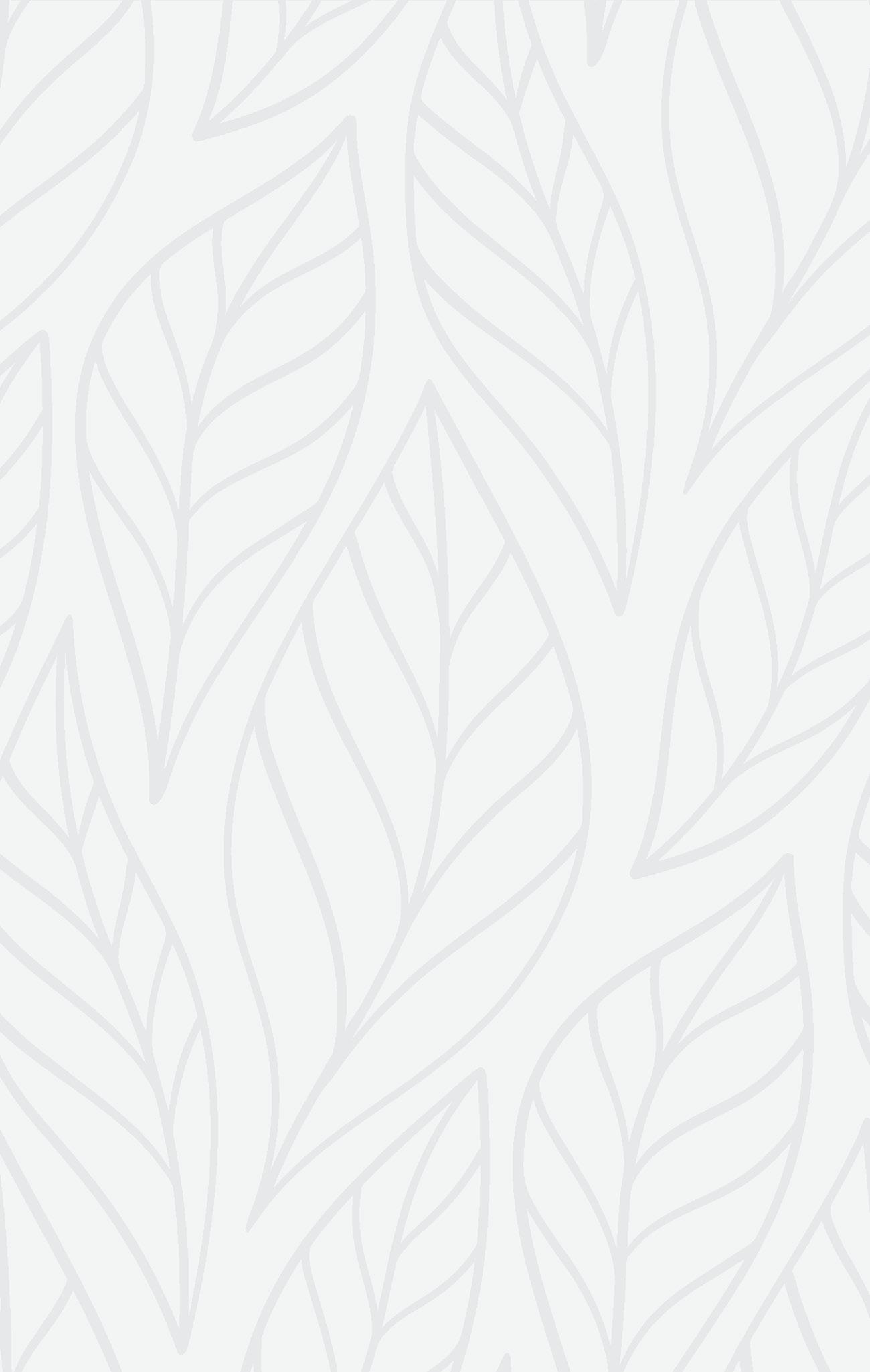
4. Has an ecological survey determined it is an appropriate place for tree planting?
Orla ní Dhúill is a writer and environmental activist from Dublin, based on Achill Island.
TREE PLANTING Irish Wildlife Winter '22 33
■
■
■
■
■
■
■
■
■
Co-Op 7%
"EVERY FOREST IS DIFFERENT AND THE AMOUNT OF CARBON STORED AND THE SPEED AT WHICH IT CAN BE ABSORBED IS HIGHLY VARIABLE"
IWT PHOTOS OF THE MONTH


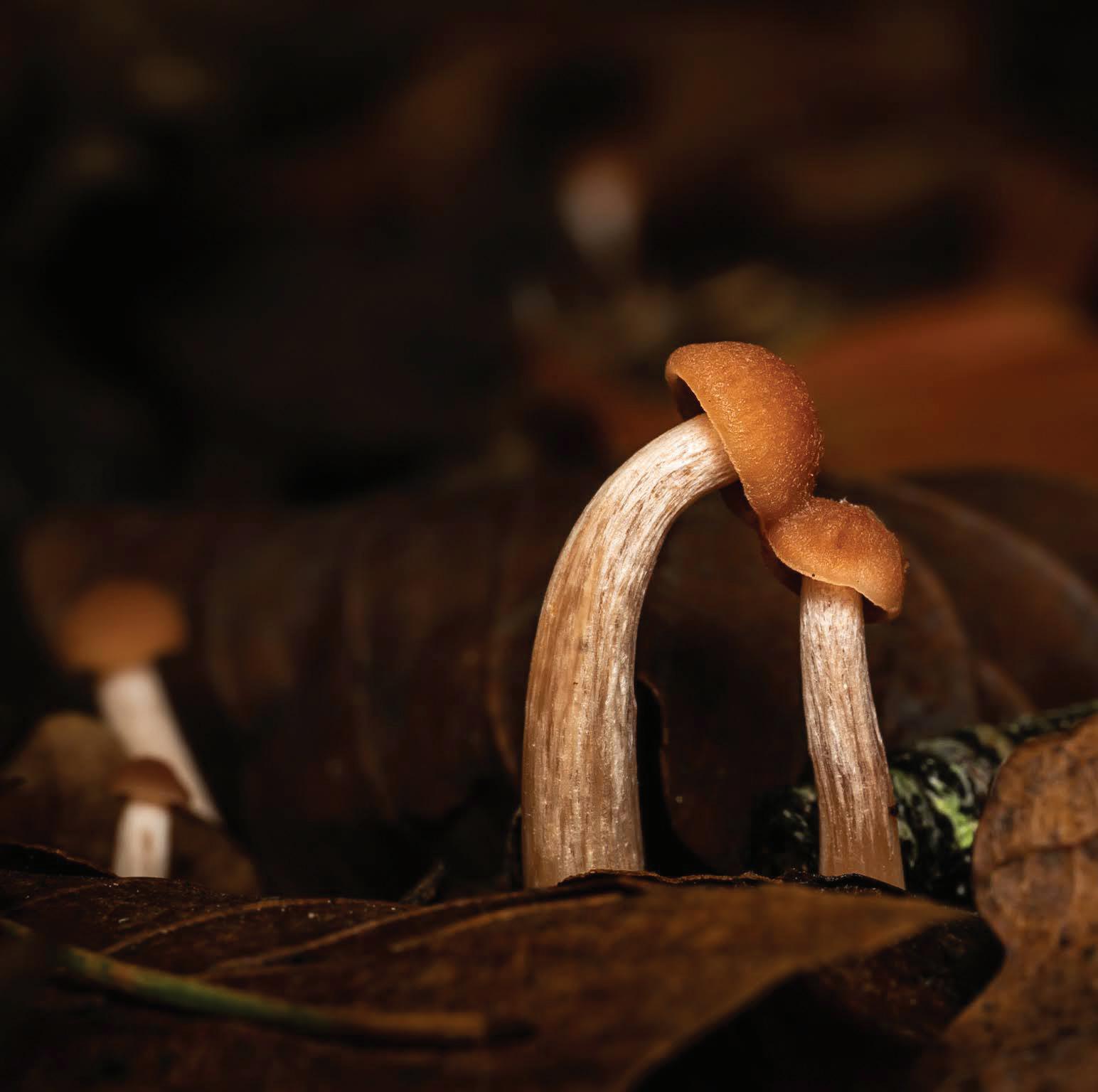
Irish Wildlife Winter '22 34
OF THE MONTH
PHOTO
4
1
2
1.


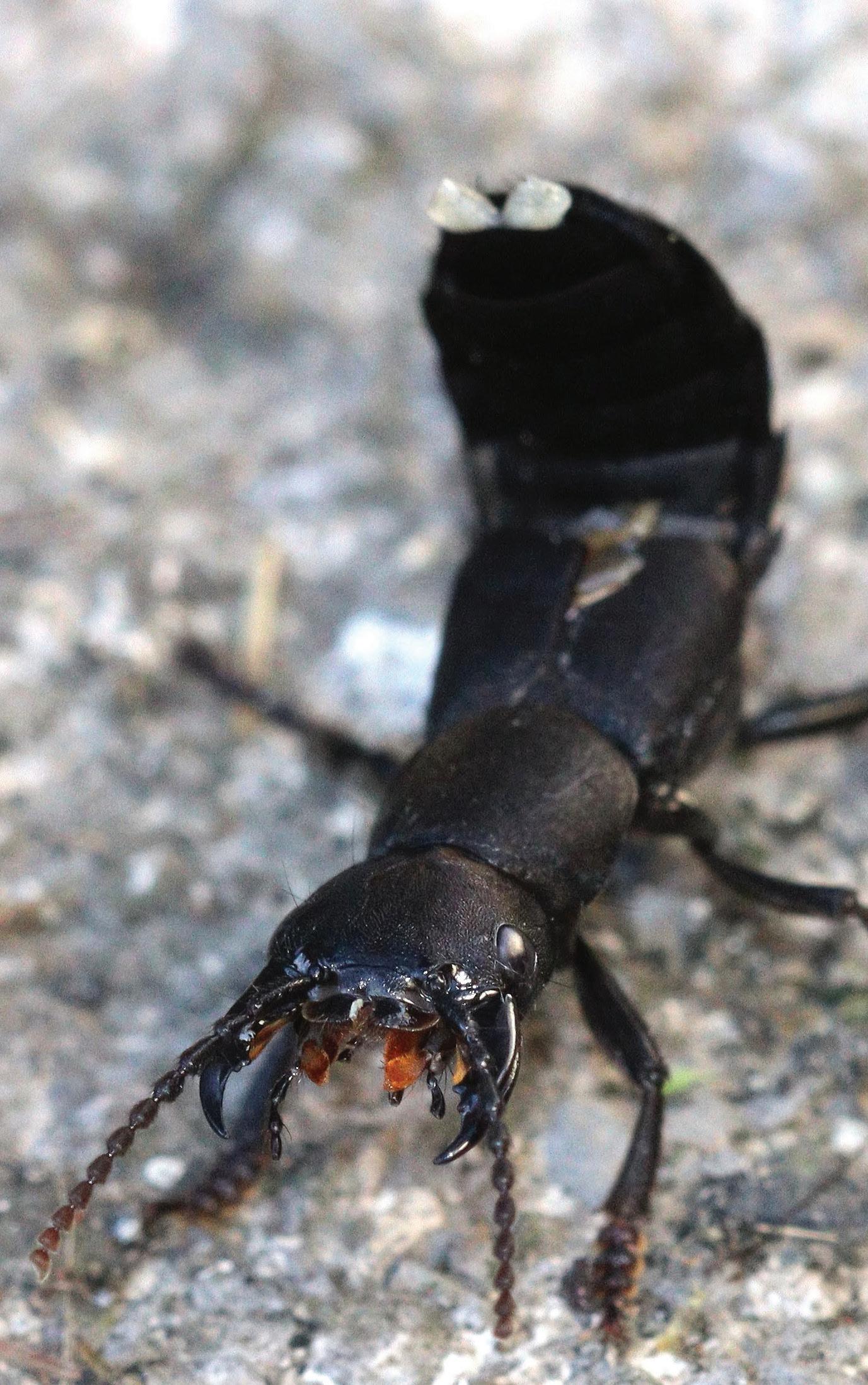

OF THE MONTH Irish Wildlife Winter '22 35
PHOTO
3.
3 5 6
Autumn mushroom by Miriam Garcia Mortell
2.
Speckled Wood Butterfly by Melissa Dowd
Two sanderling by Liam O Donnell
4.
Sabre Wasp by Andrew Malcolm
5.
Common Lizard by Jonathan Rosboroughn
6.
Devil's coach horse beetle by Marcus Maher
COMPETITION
Your chance to win a new book as well as one of our IWT branded t-shirts! We have three copies of ‘We Are e Ark’ and five T-shirts to give away
We Are The Ark by Mary Reynolds




Change can happen.









































ecosystem. It’s a thriving patch of native plants and
habitat for our pollinators and wild creatures who are in
One person, one patch of land, one decision at a time. Individuals can’t save the world alone. But if millions of us work together to save our own patch of earth - then we really have a shot. How do we do it? With Acts of Restorative Kindness, ( Arks). An ark is a restored native ecosystem. It’s a thriving patch of native plants and creatures that have been allowed to re-establish in the earth’s, intelligent, successional process of natural restoration. Over time, this becomes a pantry and a habitat for our pollinators and wild creatures who are in desperate need of support.
The ark-building actions are within our control and laid out here in ‘We are the Ark.’ In these inspiring pages, discover how one person’s actions can a ect big changes in this world, even the tiniest postage stamp patch of land matters!
You also have a chance to win one of the new designs of our organic clothes range of T-shirts. The IWT has a range of inspiring, ethical T-shirts, jumpers and tote bags in a range of styles to highlight our campaigns to protect nature. See https://iwtclothing.com/ for full details.
To win one of these great prizes just answer the following question: What species recently became the first marine fish to be legally protected in Irish waters? The answer is somewhere in this issue!
Send your answer, name, address, prize preference and the design and size of the t-shirt that you would like to win to magazinecomp@iwt.ie by January 31st 2023.
Autumn issue.
In our autumn issue we gave readers a chance to win a copy of Portal by Tina Cla ey or an IWT branded t-shirt. The answer to the question is grey seal (the species of seal found on the Great Blasket island o Kerry). Congratulations to Gearoid Jackson in Co Limerick, David Devins in Co. Leitrim, and Mark Holmes in Co. Mayo who won the book, as well as Florence McNally in Herts in the UK, Louise Mac Elwain in Co. Dublin, Michele McNulty in Co. Mayo, James O’ Connor in Co. Dublin and Patrick Ryan also in Co. Dublin who won a t-shirt. Thanks to all who entered!
Irish Wildlife Winter ‘22 36 COMPETITION
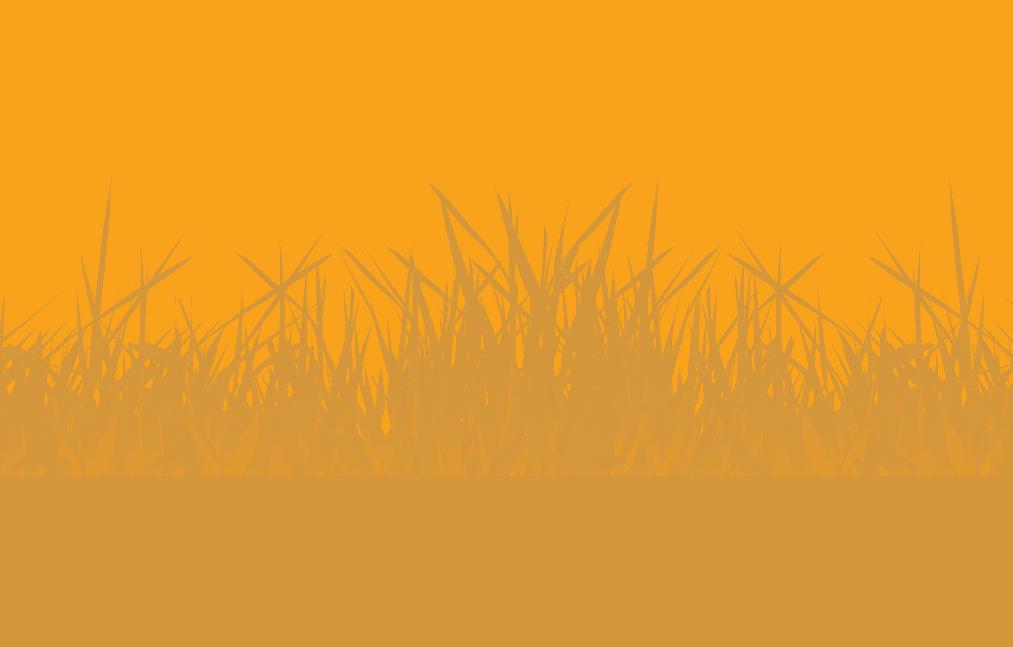
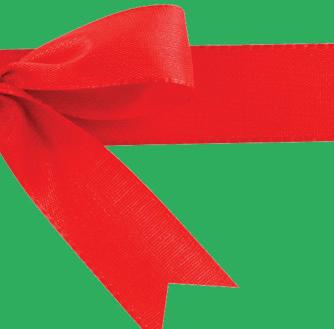









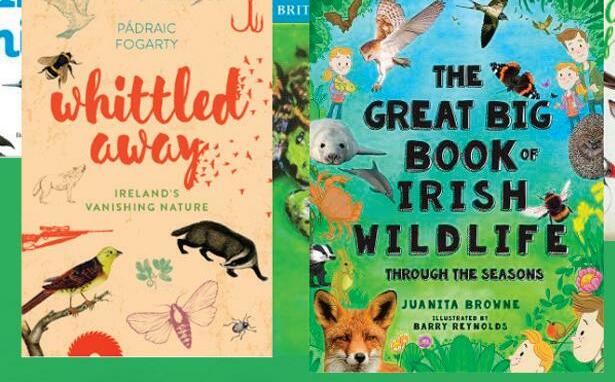




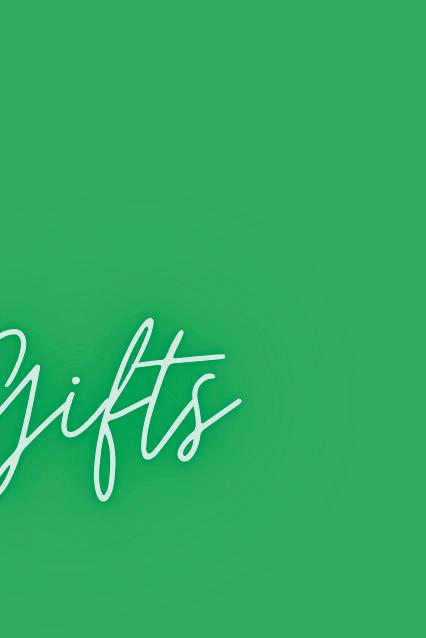



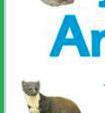
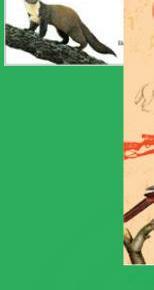


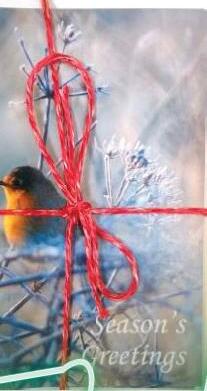


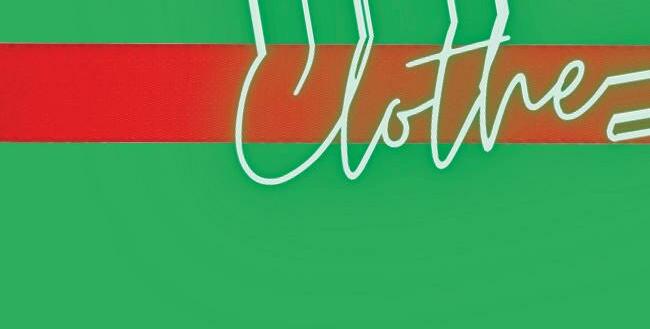





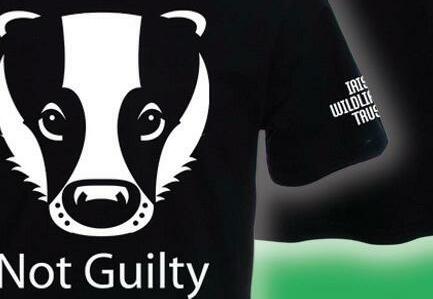

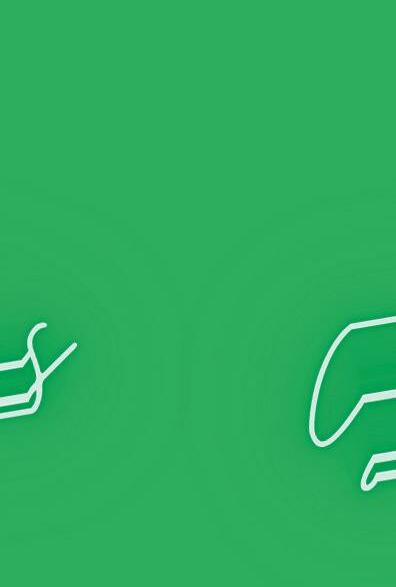
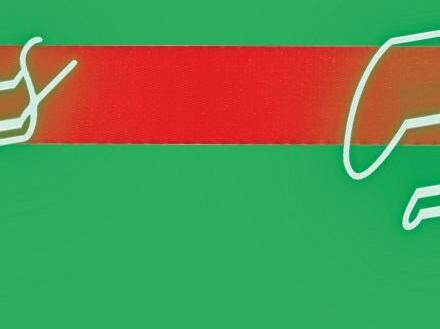
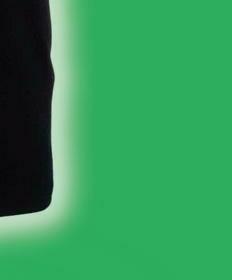

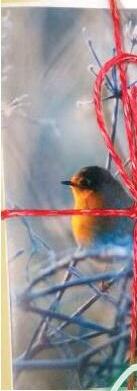
Introducing the new Irish Wildlife Trust membership card. Membership Card 2022 Individual members, please ll in your full name. Family members, please ll in your family name. Card valid until end of 2022. Please fill in your name, cut out and keep your new membership card to present at talks and other events. Cards valid until the end of 2022. iiwt.ie/shop wt.ie/shop
























































 "AS OF OCTOBER 3RD 2022, BASKING SHARKS IN IRISH WATERS ARE LEGALLY PROTECTED UNDER SECTION 23 OF IRELAND’S WILDLIFE ACT"
Basking shark by Mike Brown
"AS OF OCTOBER 3RD 2022, BASKING SHARKS IN IRISH WATERS ARE LEGALLY PROTECTED UNDER SECTION 23 OF IRELAND’S WILDLIFE ACT"
Basking shark by Mike Brown





















































































 BY GORDON D'ARCY
BY GORDON D'ARCY

 BY BILLY FLYNN
BY BILLY FLYNN
























































































